Hot Shoe Magazine
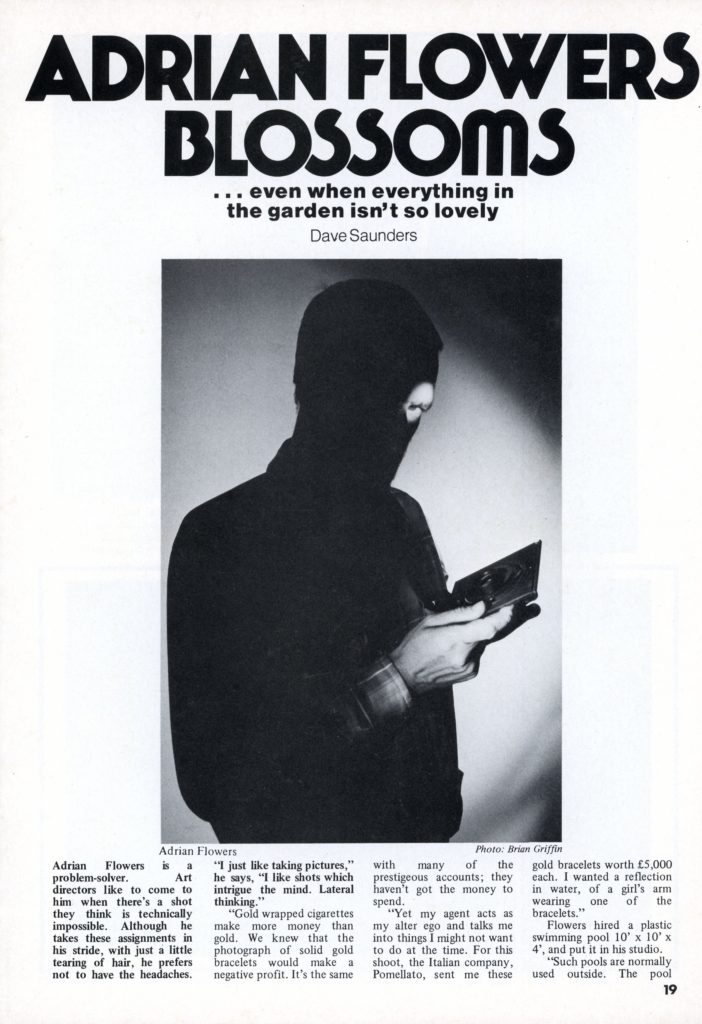

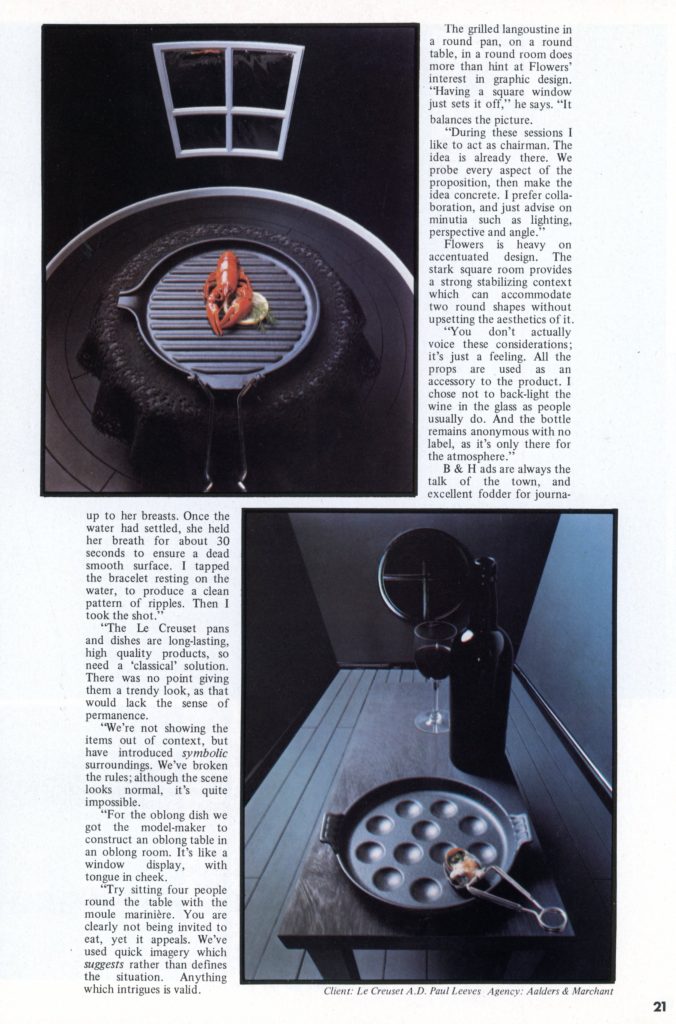
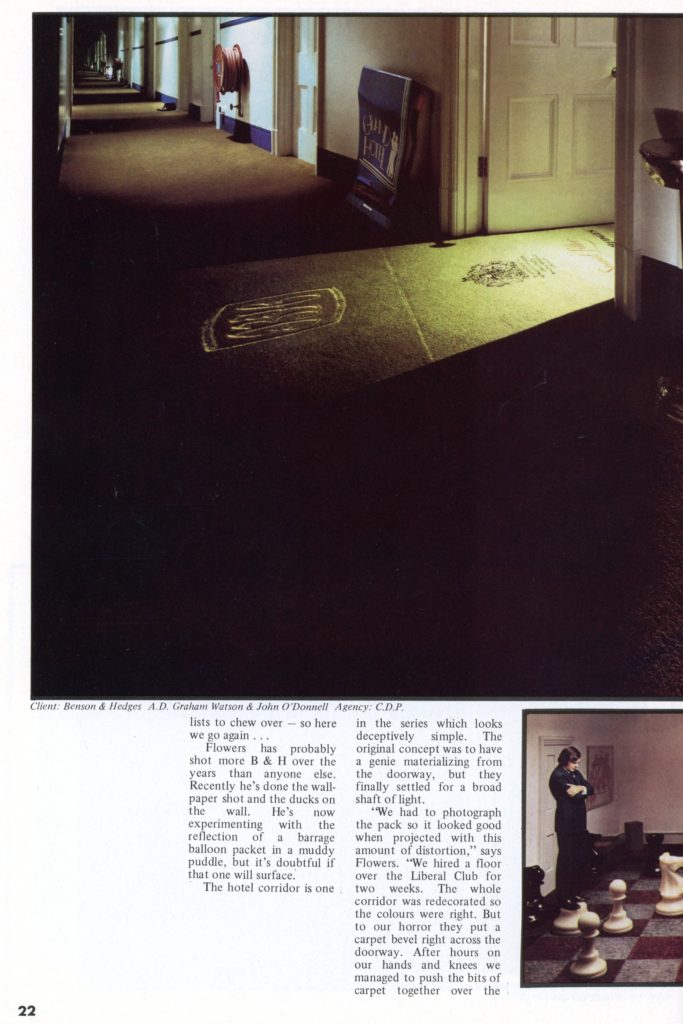
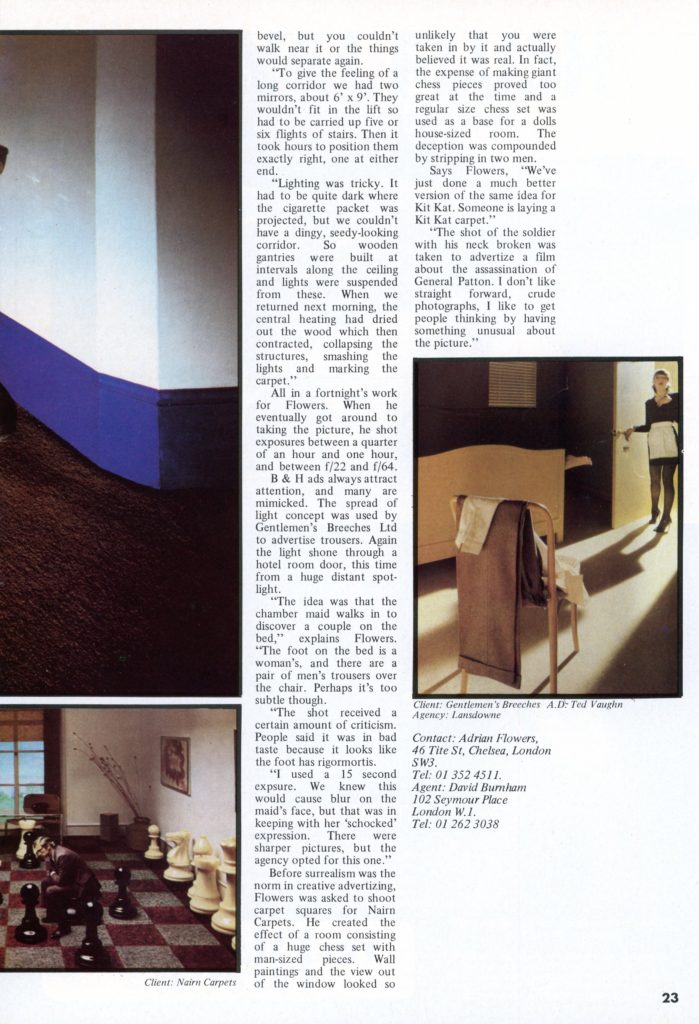
Hot Shoe Magazine





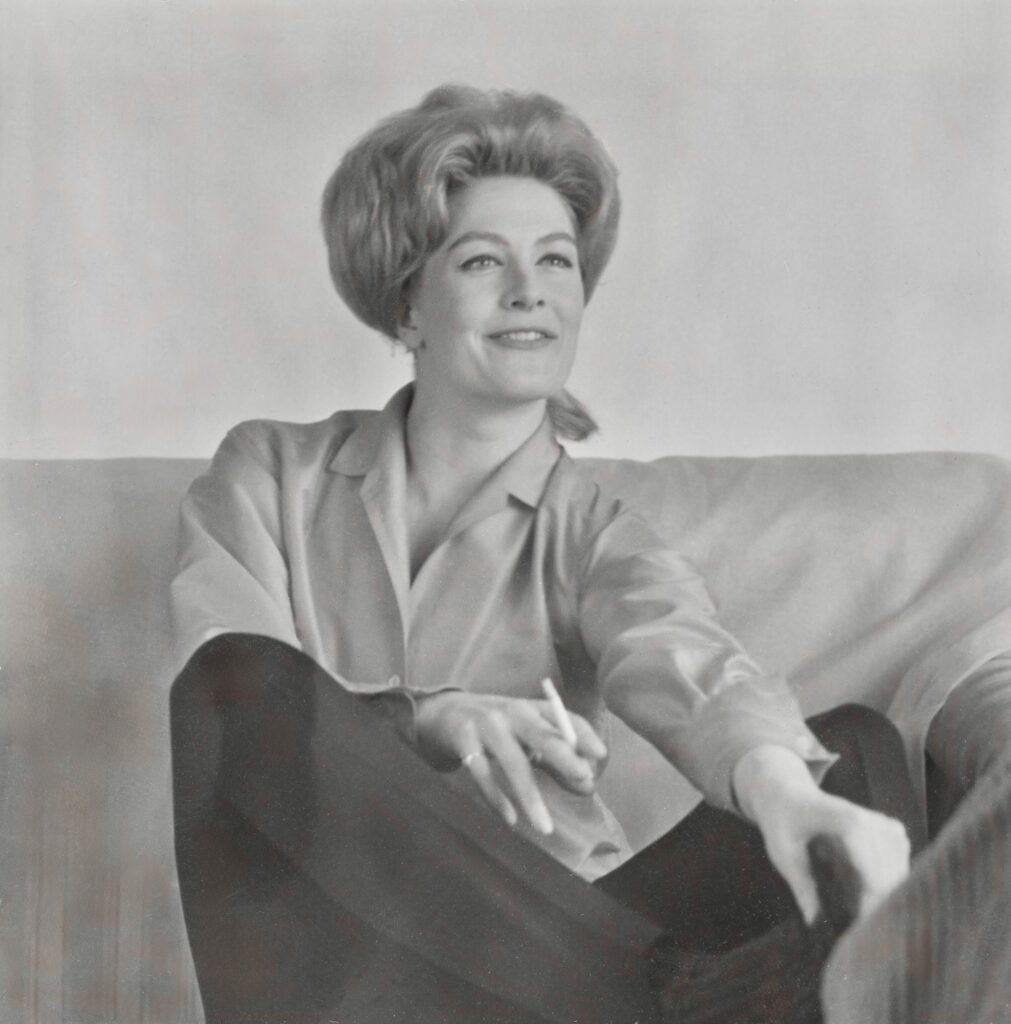
Born in Blackheath in 1937, the actor and activist Vanessa Redgrave comes from a family already famous in the world of stage and screen. The daughter of Sir Michael Redgrave and Rachel Kempson, and sister of Colin and Lynn Redgrave, after studying at the Central School of Speech and Drama, in 1958 she made her stage debut in A Touch of Sun. The following year she appeared in A Midsummer Night’s Dream and two years later was widely praised for her portrayal of Rosalind in the Royal Shakespeare Company’s productions of As You Like It.In 1962, still a rising star in the world of theatre, and by now married to the film director Tony Richardson, Redgrave played Imogen in Cymbeline, directed by Bill Gaskill for the RSC at the Aldwych Theatre. That year she featured in Mademoiselle magazine in the United State, with photographs by Sandra Lousada and was also on the cover of the June 4th international issue of Life magazine, dressed for her role as Rosalind.
On Monday 22nd January 1962, Redgrave’s name appears in the studio diary of the Adrian Flowers studio: “7.30 Flair Vanessa Redgrave 13 Grenvill Pl FRE2591 . . pale yellow walls blue velvet dress”. Judging by the entry, the appointment was for a planned article in Flair magazine. While bearing the same name as the magazine founded by Fleur Fenton Cowles in 1950, the Flair magazine for which Adrian Flowers photographed Redgrave was a quite separate publication, specializing in fashion and beauty as well as feature articles. The diary entry indicates that the photograph session was to take place in Kensington; 13 Grenville Place is just north of Cromwell Road. The twelve photographs taken that evening are all informal, with Redgrave laughing, chatting and posing for the camera. While contact sheet 4169 consists of three strips of four images, making a total of twelve, one of the original negative strips is missing from the AF Archive—perhaps because it was sent to Flair magazine.
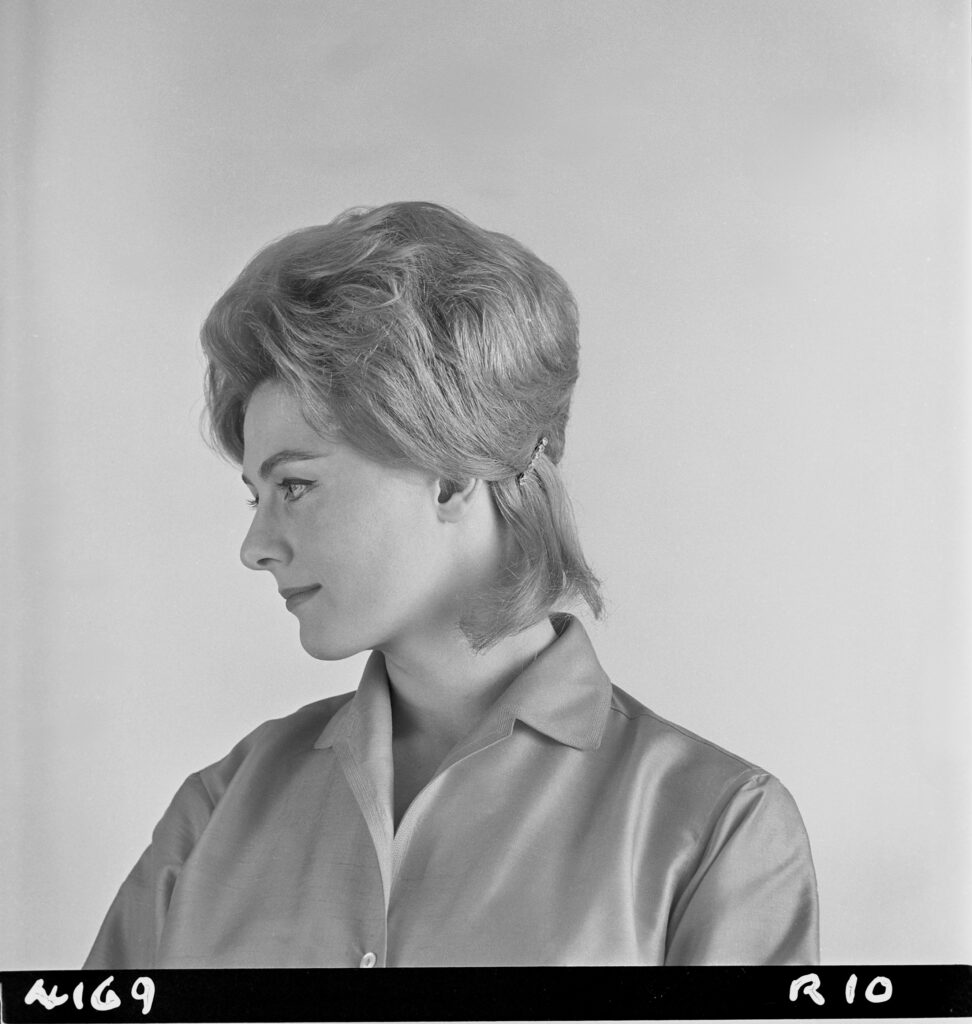
The images are beguiling. A seasoned professional, Redgrave is both relaxed and also aware of the camera, turning her head, smiling, and radiating confidence and a warm human spirit. Since infancy, she had been photographed by some of the top names in photography, including Angus McBean, Yousuf Karsh, George Konig, Paul Tanqueray, and, in 1962, by Tony Eyles. Seven of the photographs by Adrian Flowers are head and shoulders, while the rest show her dressed in a high-necked shirt, with dark slacks and stockinged feet, sitting informally on a couch, legs crossed or feet resting on a low table. She wears no jewellery, little make-up, and her abundant hair is pinned back with a hairclip. The couch has sheets draped over it, to conceal the brightly patterned fabric. In several, she is smoking a cigarette. The background is a plain wall.In a period when portrait photography emphasized fashion, make-up and accessories, these photographs by Adrian Flowers stand out as a record of the person Vanessa Redgrave, direct, honest and fearless, rather than portraying her as a star of stage and screen.
Text: Peter Murray
Editor: Francesca Flowers
All images subject to copyright.
Adrian Flowers Archive ©
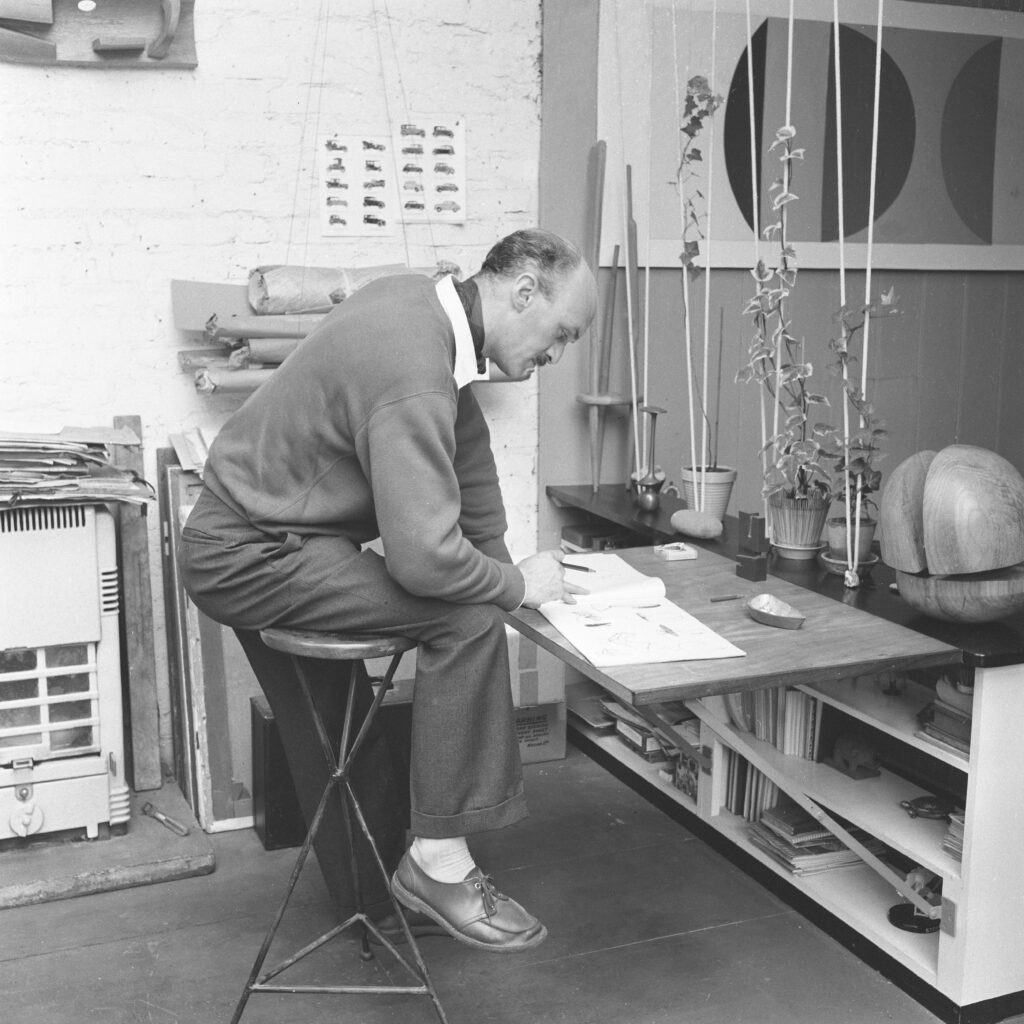
During the 1950’s and 60’s Adrian Flowers photographed the painter and sculptor Robert Adams on several occasions. One photo, taken around 1955 [AF 1750], shows Adams in his studio in London, sitting casually on a high stool made of welded metal, poring over a sketchbook on a drawing table. The form and construction of the stool suggests it was made by the artist. On a shelf are several of Adams’ sculptures. One, a small bronze work, part of the Growing Form series, dates from around 1953. Another relates to the ‘Penwith Forms’ series, and dates from 1955. Adams has dressed elegantly for the occasion of Flowers’ visit, and is wearing a white shirt and cravat. Behind the artist are rolls of drawings, cleverly suspended in loops of string. The drawing table is a fold-out affair, part of a room divider that also contains bookshelves. A large abstract painting can be glimpsed in the background. Another photograph taken on that same visit shows Adams working on a tall wooden sculpture. The sculpture stands on a workbench in the same studio, with its white-painted brick walls and overhead girders. On the walls are T-squares, a brace, saws and loops of wire. A third photograph shows Adams, his wife Patricia and their dog Tishy, surrounded by sculptures, including a welded metal piece from c. 1950, one of an abstract series inspired by drawings of dancers.

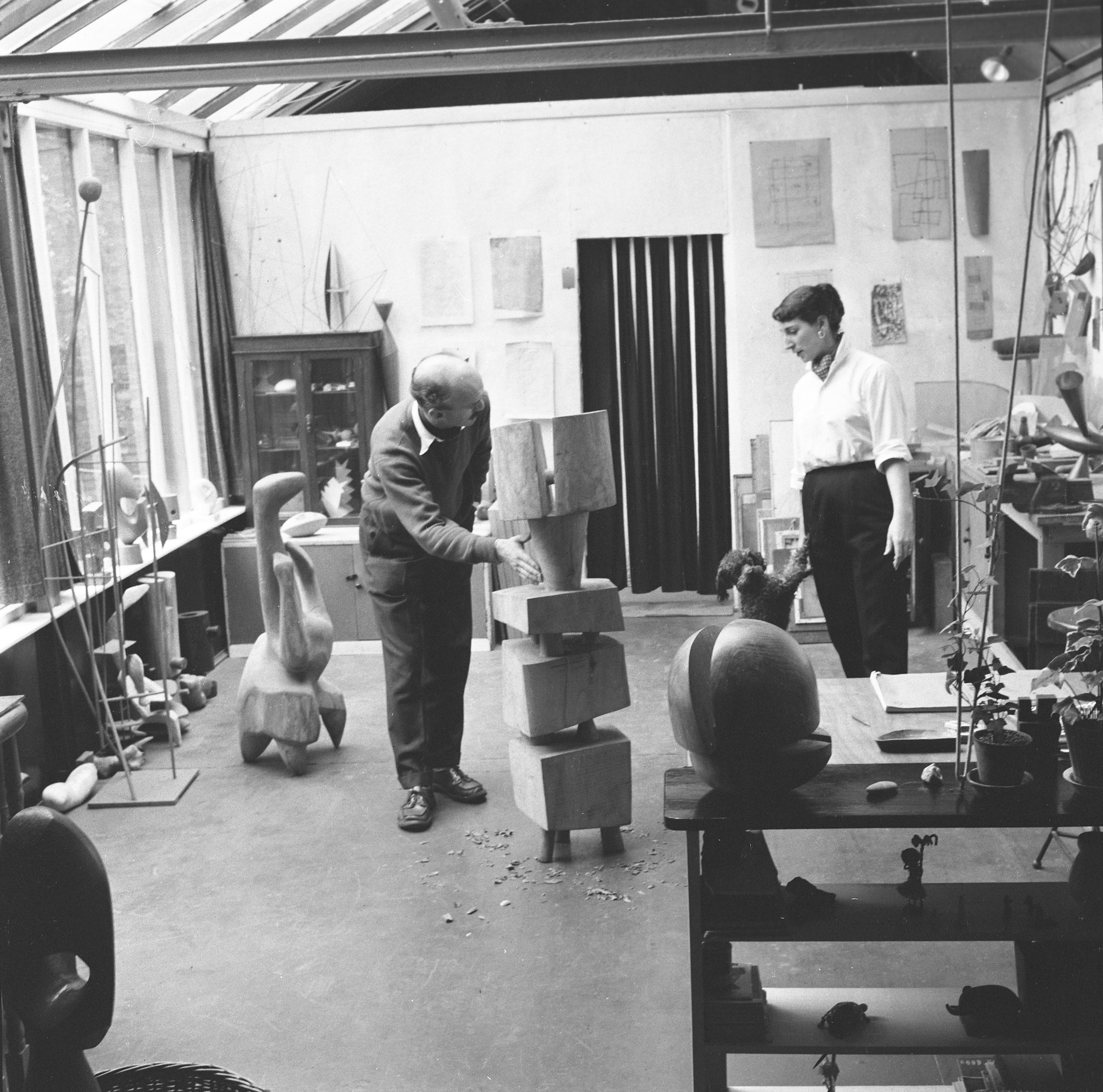
Several years later, around 1960 [AF 3376], Flowers photographed Adams in a park, with houses in the background [perhaps Hampstead Heath?], standing beside a large sculpture, made of straight lengths of metal rod welded together. This work is likely Triangulated structure No. 1, its form evoking the facets of a crystalline rock formation. Another set of photographs [AF 4217, 3376] taken around 1961, show Adams standing in his studio, surrounded by tall welded-metal sculptures. By this date, the artist’s work has evolved, and his now making tall free-standing and wall-mounted abstract pieces, in which circular plate-like forms are counterpoised with slender vertical and horizontal rods and bars. Adams also appears more confident in this set of photographs, smiling, relaxed, leaning against the wall. Another set of negatives [AF 2576] are of Adams’ carved wood sculptures set on plinths, and wall-mounted reliefs, displayed within a classical house setting. The sculptures on plinths are paired forms, evoking the streamlined wings and fuselages of aeroplanes.
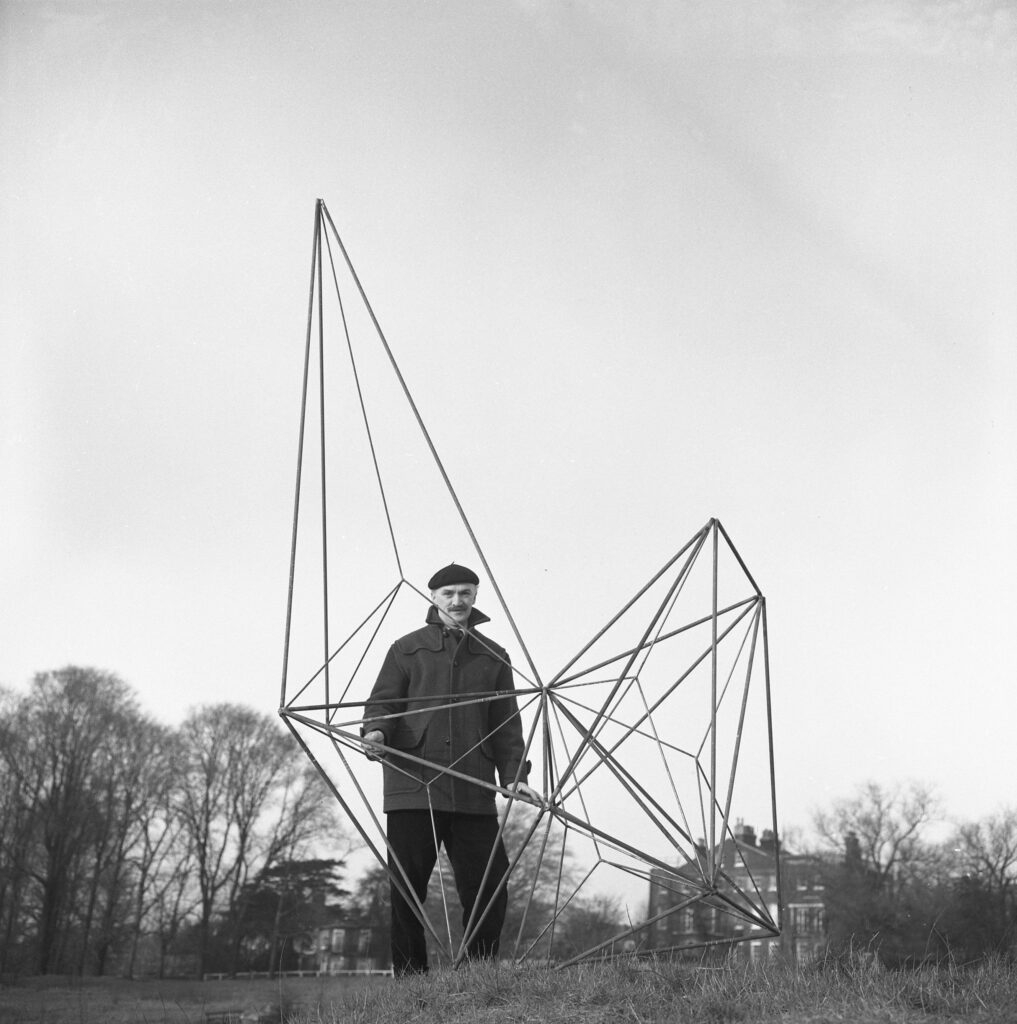
Adams had a good grounding in the technical aspects of sculpture. Having left school in Northampton aged fourteen, he worked for a local firm that manufactured agricultural machinery. From 1937 to 1946 he attended life drawing and painting classes at Northampton School of Art, and during WWII was a fire warden in Civil Defence. He first showed his work in a series of exhibitions held at the Cooling Gallery in London, along with other artist members of Civil Defence. In the post-war years he turned firstly to abstract painting, then sculpture, working mainly in wood, slate, plaster and stone. Although he remained a resolutely abstract artist, in Adams’ work there is always an underlying regard for the world of nature, and for plant and human forms. In 1949 he began to work in metal and for a decade after, in addition to making his own work, taught at the Central School of Art in London. He was influenced by, and became part of, the London Group of constructionist artists that included Adrian Heath, Anthony Hill, Victor Pasmore and Kenneth and Mary Martin. In 1947 Adams was included in the inaugural exhibition of Living Art, held in Dublin, as well as having the first of a series of exhibitions with Gimpel Fils in London. Shortly afterwards he travelled to Paris where he encountered the work of Brancusi and Julio Gonzalez. In 1949 he showed at Galerie Jeanne Bucher in Paris, the Redfern Gallery in London, and, the following year, at the Passedoit Gallery in New York. In 1951 he was invited to exhibit at the Sao Paulo Biennial and the following year was included with the group of young British sculptors in the British pavilion at the Venice Biennale whose work, using innovative techniques and breaking with traditional approaches to realist sculpture, led Herbert Read to coin the term Geometry of Fear.
In 1955 Adams had an exhibition at the Victor Waddington Gallery in Dublin, and also showed at Rutgers University that same year. Included in the Whitechapel Gallery’s influential 1956 exhibition This is Tomorrow, he was a frequent visitor to St. Ives, where he met Michael Snow, and in 1975 became a member of the Penwith Society. In 1962 a retrospective of his work was held at the Venice Biennale; another retrospective took place at the Campden Academy in Northampton in 1971, followed by one at Liverpool Tate in 1982. Adams was commissioned to make several public sculptures, including, in 1973, a large steel work for Kingswell in Hampstead. Beginning in the 1960’s, he also produced lithographs with abstract geometric designs, such as Screen II. His work has been catalogued by Alistair Grieve, in Robert Adams 1917-1984: A Sculptor’s Record (Tate Gallery 1992) and The Sculpture of Robert Adams (Lund Humphries 1992).
Robert Adams’ work featured in the 2022 exhibition at the Barbican Gallery, Postwar Modern: New Art in Britain 1945-1965.

Text: Peter Murray
Editor: Francesca Flowers
All images subject to copyright.
Adrian Flowers Archive ©
(b. 5th September 1931)
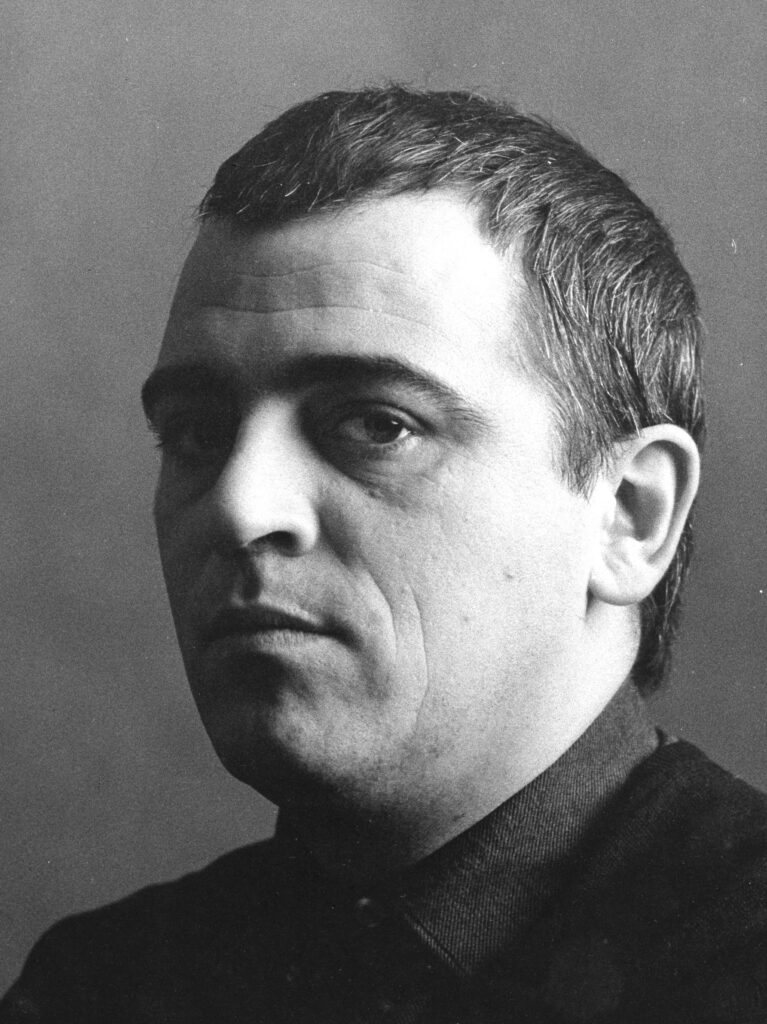
In 1956, Adrian Flowers visited the sculptor Brian Wall at his studio at Custom House Lane, Porthmeor in St. Ives. Using 120mm colour transparency stock, Flowers photographed a series of painted wood constructions by Wall, setting them up not in the studio but in the open air, on the flat sands of the beach. With titles such as Construction No. 1 and Construction No. 10, the modular black and white frames of these early works by Wall suggest the steel supports of Modernist buildings, while their inner panels, painted in primary colours, are in some ways the realisation in three-dimensional form of paintings by Mondrian.
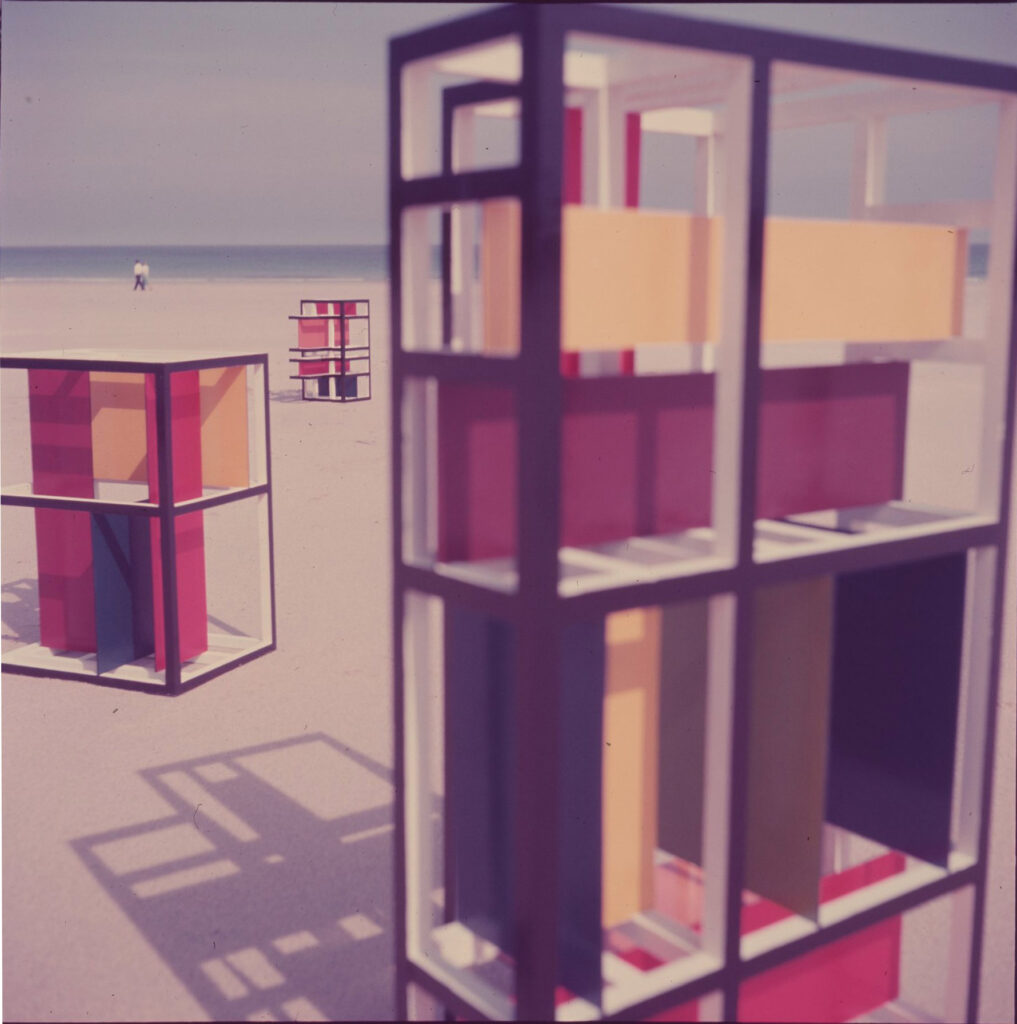

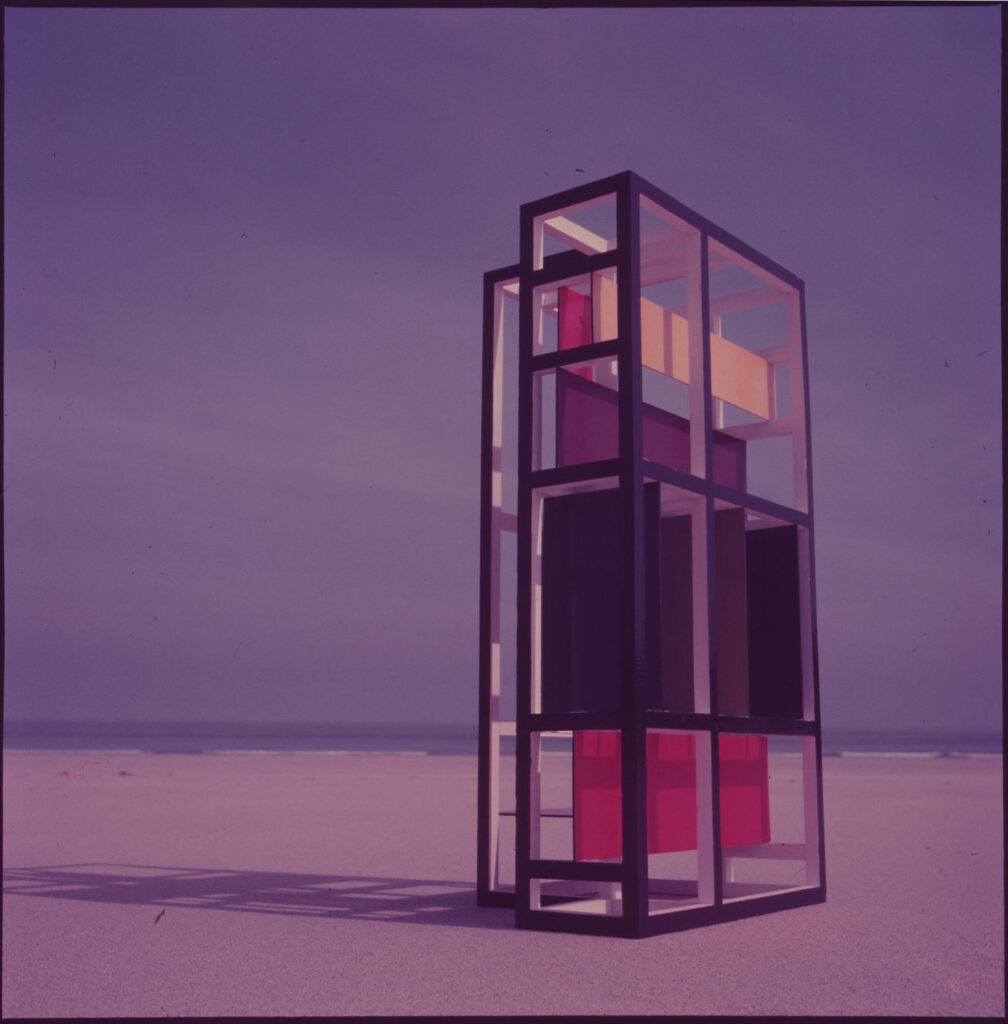
Flowers photographed Wall and his sculptures several times over the following decades. A sequence of black and white portrait shots taken in February 1963 show Wall assuming various poses; seated, in close-up, head and shoulders, smiling, smoking a cigarette, making funny expressions, hand under chin. He appears by turns thoughtful, quizzical, good-humoured, tough and determined. One sheet of contact prints shows him seated on a high stool. A folder [ref 4456] also contains several large-scale prints, made from these negatives.

Born in Paddington on 5th September 1931, Brian Wall’s childhood was spent in London, although during WWII he was evacuated to Yorkshire. After the war he left school, aged fourteen, to work as a glassblower in a factory. In 1949 he enlisted in the RAF for two years, where he trained as an aerial photographer (as had Adrian Flowers and Len Deighton), before enrolling at Luton College of Art. Deciding to become a painter, in 1954 Wall settled in St. Ives, where initially he worked at the Tregenna Castle Hotel. Shortly afterwards he met Peter Lanyon, who helped him find a studio in Custom House Lane, where Wall worked alongside Terry Frost, Patrick Heron and Sandra Blow. In 1955 he was introduced by Denis Mitchell to Barbara Hepworth, becoming her first studio assistant. He also met David Lewis, who had written on the work of Mondrian and Brancusi, and in 1956 was elected a member of the Penwith Society, exhibiting his work in the Society’s annual shows.
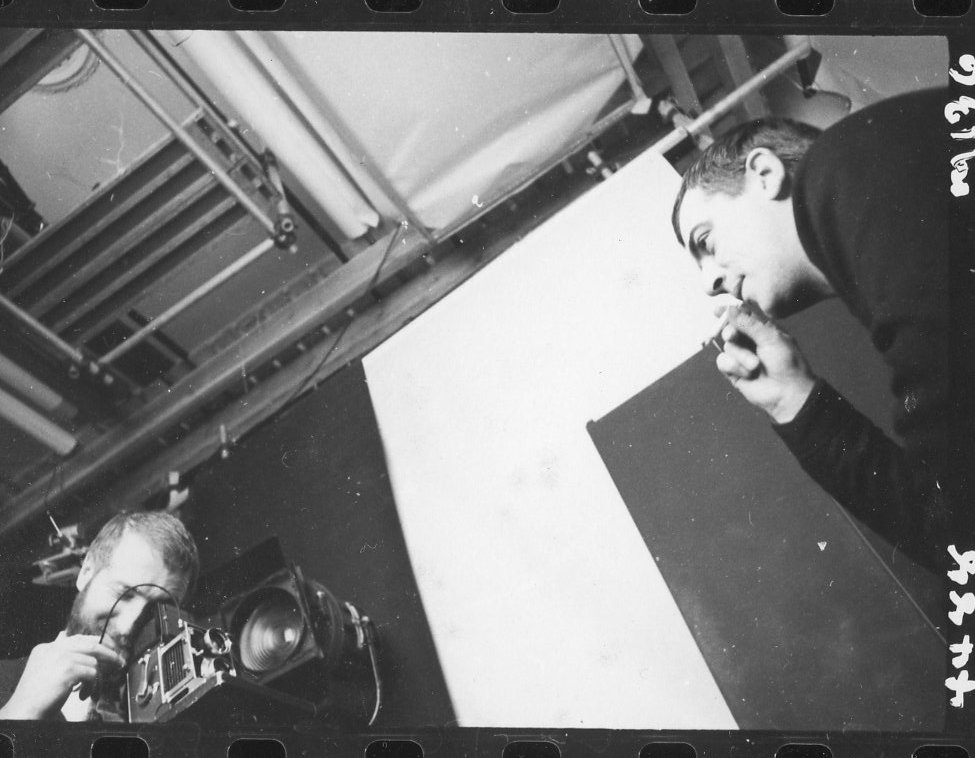
During these years, starting with the painted wood constructions, Wall developed his own sculpture practice, but quickly moved on making works in welded steel. The year after his first one-person show at the Architectural Association in 1957, he was included in the Arts Council exhibition Contemporary British Sculpture, and he also showed with the Drian and Grabowski galleries. In 1959, an article on his work was published in Architectural Design. Moving back to London, Wall became active in fine art education, serving on the National Council for Diplomas in Art and Design, and also on the Arts Council of Great Britain. In 1961-2, he taught at Ealing College of Art, before being appointed Head of Sculpture at the Central School of Art (now Central St. Martins), where William Turnbull and Barry Flanagan were also teaching. In 1961 Wall represented England at the 2nd Paris Biennale, and over the following years his work was shown in exhibitions throughout Britain. He featured in Bryan Robertson and John Russell’s 1965 Private View, a book documenting the rise of London as a centre for contemporary art.
A subsequent set of photographs [ref 5562] taken in London by Adrian Flowers record a series of medium and smaller sized welded steel sculptures by Wall, such as Untitled Steel Sculpture, Black 1964. Some were photographed in a studio setting, others in a laneway outside the artist’s studio. Several feature discs, and circles juxtaposed with straight pieces of steel, such as One Disc (1966); others are purely angular and geometric. Other photographs show the artist in his home, with family members, sculptures displayed on tables, and a geometric abstract painting on the wall.

In 1967 Wall had a solo exhibition at the Arnolfini Gallery in Bristol and was included in the Tate’s British Sculpture in the Sixties. On 25th March of the following year his Always Advancing, a large public sculpture in the form of two A’s, was sited at Thornaby-on-Tees in Yorkshire. In 1968, Wall’s sculptures were included in an exhibition organised by the Whitechapel Art Gallery, New British Painting and Sculpture, that toured to cities in North America, including Portland, Vancouver, Chicago, Houston and San Francisco. The artist visited the US several times, becoming friendly with Mark Rothko, Barnett Newman and the writer Clement Greenberg. In 1969, when the exhibition was shown at the art museum at Berkeley University, he was invited to become a visiting Professor there, and returned the following year, becoming a permanent faculty member in 1972. Although there were artists working in steel before Wall settled in San Francisco, they tended to work in less ‘pure’ modes. His presence in the area influenced several artists, including Fletcher Benton, to begin working directly, in a more abstract way, with welded steel. Taking up US citizenship, Wall became recognised more as an American sculptor and was appointed Chair of the Art Department at Berkeley, a post he held until his retirement in 1994. Throughout his teaching career, he continued to make his own work, setting up a studio and workshop in Oakland, where his assistant is the sculptor Grant Irish. He prefers to make his sculptures directly, working with pieces of steel on a one to one scale, rather than constructing maquettes, or working from drawings. This invests Wall’s work with qualities of lightness that are often absent in large-scale abstract metal sculptures. His pieces appear to teeter, tilt and turn. Circles, cylinders, I-beams and plates hover and jostle playfully. In spite of the massive scale, and the industrial materials he employs, there is a palpable pleasure and joy in his work.
Although Wall rejects the term “Constructivist” to describe his work—on the basis that his work does not relate to architecture, but emerges from a process of intuitive development—there is no mistaking the Central European and revolutionary Russian tradition of industrial materials used to make abstract art. This Constructivist tradition had been promoted in Cornwall during the war years by Naum Gabo, leading Ben Nicholson to adopt a pure minimalist approach to abstraction. Nicholson was an early influence on Wall who, from the outset, steered clear of the expressionist styles of Lynn Chadwick, Reg Butler and Kenneth Armitage, as well as the organic forms of Hepworth and Henry Moore.
A retrospective exhibition of Wall’s sculptures, organised by the Seattle Art Museum in 1982, toured to SFMoMa. The exhibition included two early St. Ives painted wood constructions; Metamorphosis (1955) and Right Angle Deck Construction with Vertical Movement (1956)—both revealing how close the artist had been to architecture at the outset of his career. Although most of the works in the Seattle show were from the 1960’s and 1970’s, including the brightly-painted Early Yellow (1975), there were more recent sculptures too, including October Jump (1981), in which two I-beam girders are supported by cylindrical and plate steel forms. Through the last four decades, Wall continued to exhibit in the UK, showing at Flowers Gallery in 2008 and 2011; he also showed with Flowers in Los Angeles, Max Hutchinson in New York, and with John Berggruen and Hackett Mills in San Francisco. In 2006, a monograph on his work, written by Chris Stephens, was published by Momentum Press 2006, and in 2014 Wall established a foundation to benefit working artists. As recently as 2015 a solo show held at the de Saisset Museum at Santa Clara University featured sculptures monumental in scale but light in feeling, reflecting Wall’s interest in Zen Buddhism—an interest which began in St. Ives in the 1950’s, and continues to inspire his work to the present day.
Text: Peter Murray
Editor: Francesca Flowers
All images subject to copyright.
Adrian Flowers Archive ©
For further reading, refer to Brian Wall by Chris Stephens, Suzaan Boettger and Barry Munitz. Momentum publishing 2006.

(1920 – 2018)
Although still in her early forties when photographed by Adrian Flowers in March 1961, Kató Havas had already gained a reputation as one of the leading violin teachers in Europe and the United States. The photographs taken by Flowers that day show Havas demonstrating her technique of playing the violin, an approach more relaxed than the traditional concert style which had carried over from the nineteenth century. In some of the portrait photographs, a dark-haired and stylishly dressed Havas, holding her violin, looks directly at the camera. Other images show her playing, bow in her right hand, and left elbow directly below the violin. This was the loose, fluid style of playing that Havas had witnessed as a child, when she saw Gypsy musicians playing in her native Carpathia, and which she developed into the technique for which she became famous.
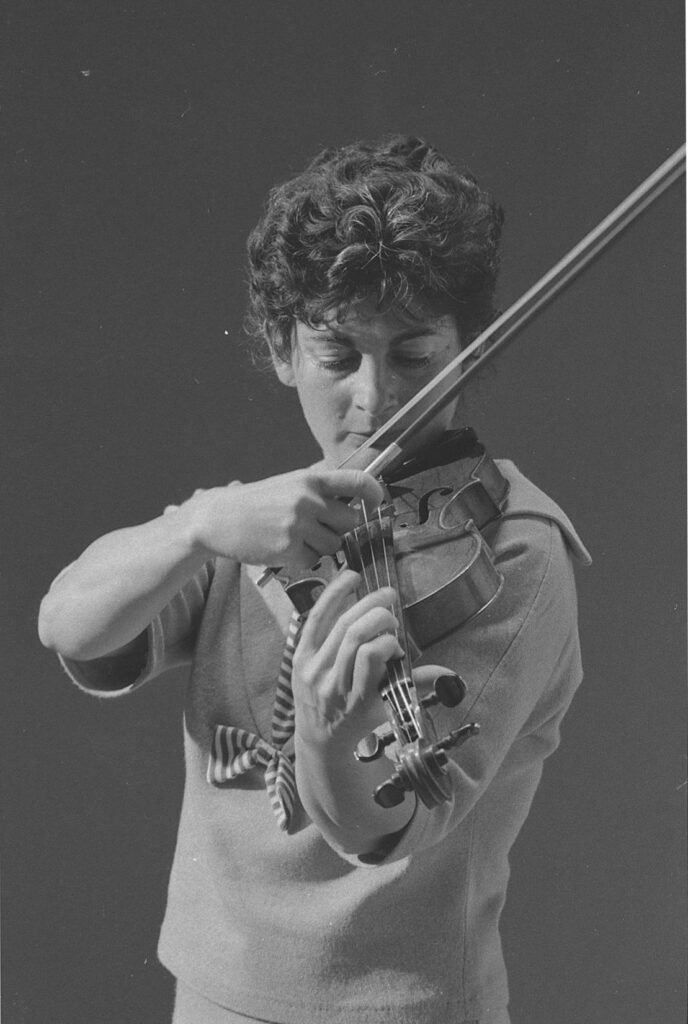
Born in the market town of Târgu Secuiesc (Keszdivasarhely) in the Carpathian mountains, from an early age Havas’s parents, Sandor and Paula Weinberger, had encouraged her music studies, following the pedagogical system then being developed by Zoltan Kodály. In 1927, aged seven, Havas gave her first professional recital at Kolozsvár, playing works by Brahms and Schubert, and the following year enrolled at the Franz Liszt Academy in Budapest, where she studied under Imre Waldbauer. Whilst a student, she met Bartók, Kodály and Dohnányi, with all three attending her first recital at the Academy. It was during this time that the pressure of performance began to affect Havas’s playing; the rigid technique she had been taught was causing tendonitis and other physical problems. In 1939, she travelled to the United States, making her debut at Carnegie Hall, and also learning, from David Mendoza, a more natural left-hand method of violin playing.

The following year, giving her Hungarian ‘minders’ the slip, she eloped with the author William Woods. Had she returned to Hungary, she would almost certainly have been amongst the more than one hundred thousand Transylvanian Jews who were exterminated in death camps. In 1944, all the Jews of her native town Targu Sacuiesc were deported to Auschwitz. Through his writings, Woods documented a world of terror from which he had helped Kató escape: published in 1942, his debut novel Edge of Darkness documents Nazi atrocities in Norway. This was followed with Manuela (1958) a novel recounting the story of a middle-aged ship’s captain who falls in love with a young female stowaway: the film version was directed by Guy Hamilton, and starred Elsa Martinelli and Trevor Howard. Woods and Havas went on to have three daughters, Susanna, Pamela and Kate, and Havas gave up giving concert recitals, concentrating instead on developing a more natural way of playing the violin, using rhythm and song: “Hear with your eyes, and see with your left hand”, she said, emphasising that a violin player should strive to feel there was ‘no violin’ and ‘no bow hold’.
Although in 1920—the year she was born—Transylvania had been transferred from Austro-Hungarian rule to the Romanian kingdom, Havas always regarded herself as Hungarian. Unable to return to her homeland for decades because of the post-war Russian occupation, she and Woods settled in Dorset, England, where he continued his career as a screenwriter, working mainly for television. Meanwhile, Havas took up music again, teaching, writing and gaining a reputation as teacher, performer and theorist; her approach enabling many musicians to overcome stage fright, and to give more natural performances. Her first book, A New Approach to Violin Playing was published in 1961: “A warm and beautiful tone has nothing to do with talent or individual personality. It is merely the putting the right pressure, on the right pot, at the right moment.”

To achieve good results, never tell a pupil what not to do. Give her something positive to do instead. As soon as the cause of the trouble is recognized, track it down step by step with such compelling logic that there is not an atom of doubt left. Questions and discussions are to be encouraged, not only so that the pupil can work with the teacher but also to give her a chance to think things out for herself. Demonstrate: first, the incorrect way, to point out the faulty tone, and then the correct way. Results should be judged by the “degree of excellence in tone production” because the ability to listen, and listen continuously, is one of the greatest voids among young violinists (p.57).
This was followed by several publications including her 1973 Stage Fright and Freedom to Play, published in 1981. Lecturing at Oxford University and television appearances brought Havas a degree of fame. She founded and directed the Purbeck Music Festival in Dorset, as well as the Roehampton Music Festival in London, and the International Festival in Oxford. In 1971, her marriage to Woods having ended in divorce, she married Tim Millard-Tucker, a design engineer. In 1985, the “Kató Havas Association for the New Approach” was founded, and in 2002 she was invited to return to Hungary to lecture at the Academy where she had studied in the 1930’s. In 2002 she was appointed OBE. Sixteen years later, Havas died, aged 98.
She had had a worldwide influence, and among those who benefitted from her teaching were Janet Scott Hoyt, Pamela Price in Sheffield, John Ehrlich and Don Peterson in Iowa, and Claude Kenneson in the University of Alberta. For many years Claude Kenneson had taught at the Havas Summer School in Dorset, and through his writings and career he endeavoured to continue her legacy in music.
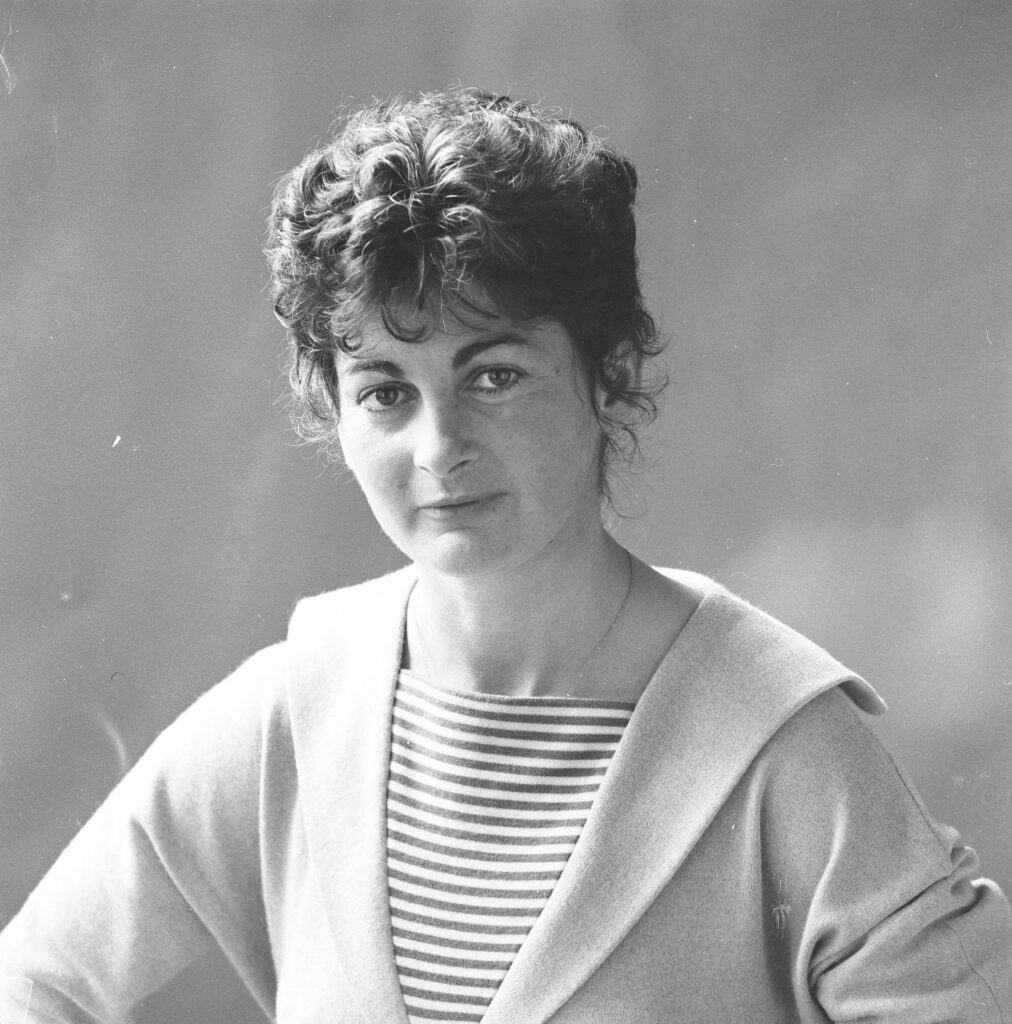
Text: Peter Murray
Editor: Francesca Flowers
All images subject to copyright.
Adrian Flowers Archive ©
Brian Duffy, photographer
1933 – 2010
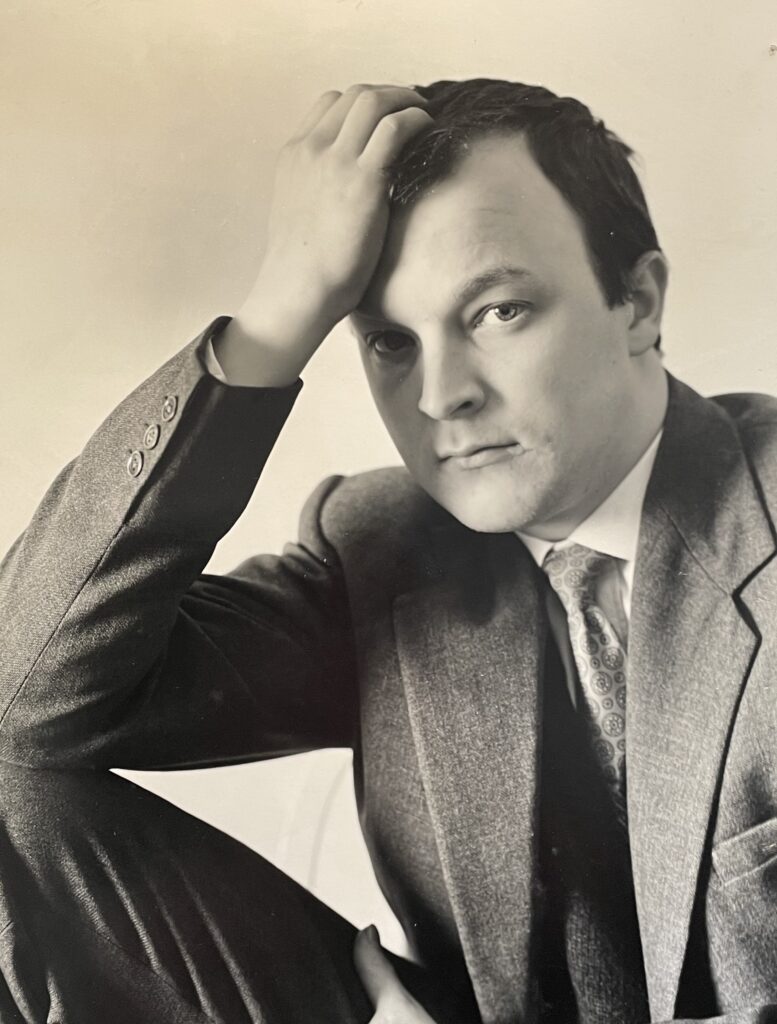
Directed by Linda Brusasco, the television documentary The Man Who Shot the Sixties recounts the life story of Brian Duffy, a portrait photographer famous for his gift of charming, enchanting—and occasionally antagonising—his sitters, but also, more importantly, for his ability to capture superb images on film. In his conversations with colleagues and clients, Duffy could be both funny and caustic, but he was a highly sensitive individual, with an intimate knowledge of the world of fashion and clothing. Famously argumentative, he often found himself in the company of the rich and famous; top models, actors and politicians, but was also on good terms with the London’s East End community, including the notorious Kray brothers. Duffy became one of the top photographers at Vogue, and was later an imaginative director of short films for rock bands, but in 1990 he packed it all in, to set up a furniture restoration workshop in Camden where he worked for the next twenty years. A star during the swinging sixties, along with Terence Donovan and David Bailey, by the turn of the twenty-first century Duffy had faded from public view. Broadcast by the BBC in 2010, The Man Who Shot the Sixties was a timely step in promoting a wider awareness of this remarkable photographer, who had died that same year.
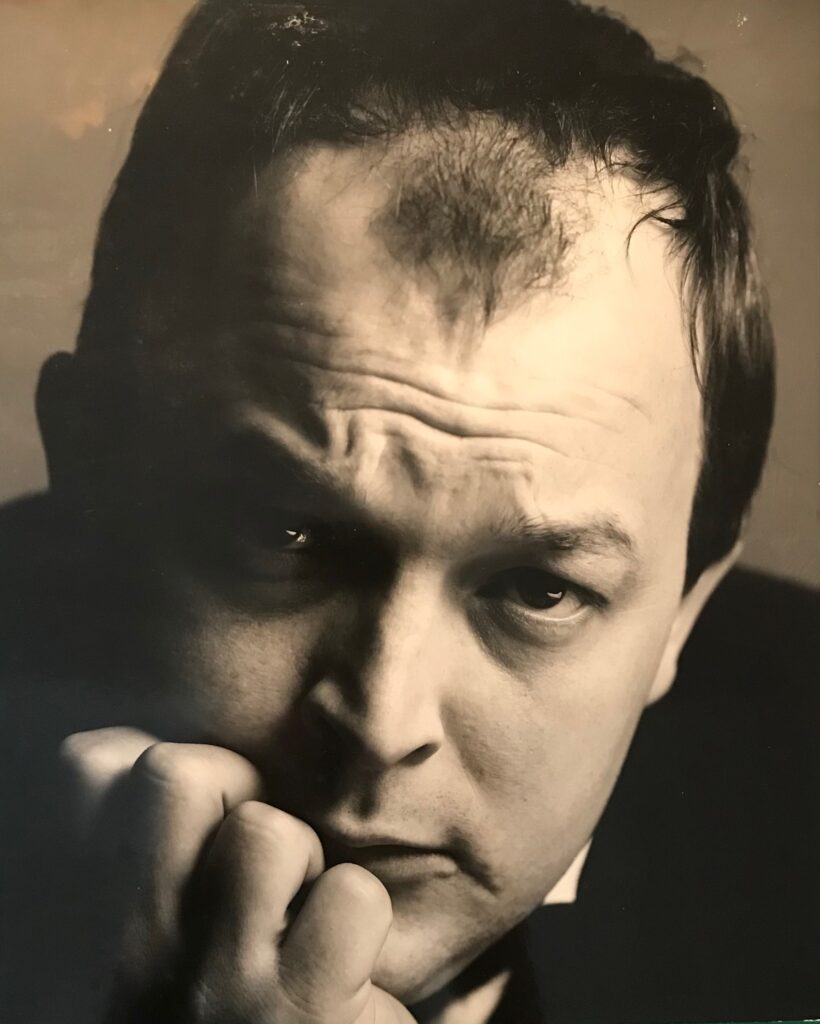
The Adrian Flowers archive includes several sets of photographs of Duffy. The earliest are individual portrait shots taken in January 1958, while the latest date from 1966, and were taken after a celebratory lunch at Alvaro’s restaurant on the King’s Road in Chelsea. In April of that year Duffy had photographed Alvaro Maccioni and his staff at the opening of the new restaurant, an enterprise which immediately rivalled the legendary Trattoria Terrazza in terms of its celebrity and film world clientele. After the lunch, on the spur of the moment, a group including Len Deighton, Duffy, Donovan, and Norman Brand, decided to call in to see Flowers at his studio on Tite Street. Ten years before, a young and inexperienced Duffy had been taken on as assistant photographer by Flowers. Norman Brand had worked for Vogue until 1962, when he joined Duffy at his studio in King Henry’s Road, Primrose Hill. Brand recalls the visit to Flowers: “I don’t know why but as we left it was decided that we would stroll down the King’s Rd and turn left into Tite Street where Adrian had his studio. After the usual chat someone said we should do a group portrait! I have always remembered this occasion and the photo being taken and always regretted never seeing the result but am thrilled to see it after all these years!” A series of photographs, formal and informal, were taken. In several of these, Duffy and Donovan pose together, laughing and joking.

There is also a series of ‘family’ portraits, where everyone assembled good-humouredly in front of the camera. In these, Adrian stands to the right, cable release just visible in his hand. Behind him, wearing spectacles and smiling, is Brand. Deighton is at the back, wearing a white linen jacket, with Donovan to his right. Tousle-headed and with his characteristic impish smile, Duffy is kneeling at the front. He is wearing a tie, as indeed are all the men in the photograph. Donovan looks particularly formal, as if about to attend a funeral. The woman wearing the fashionable trouser suit has not been identified, nor the man in the foreground, leaning on his elbow. The photograph celebrates the culmination of Duffy’s career, when he was launching himself into the world of film production, after achieving fame as a stills photographer.
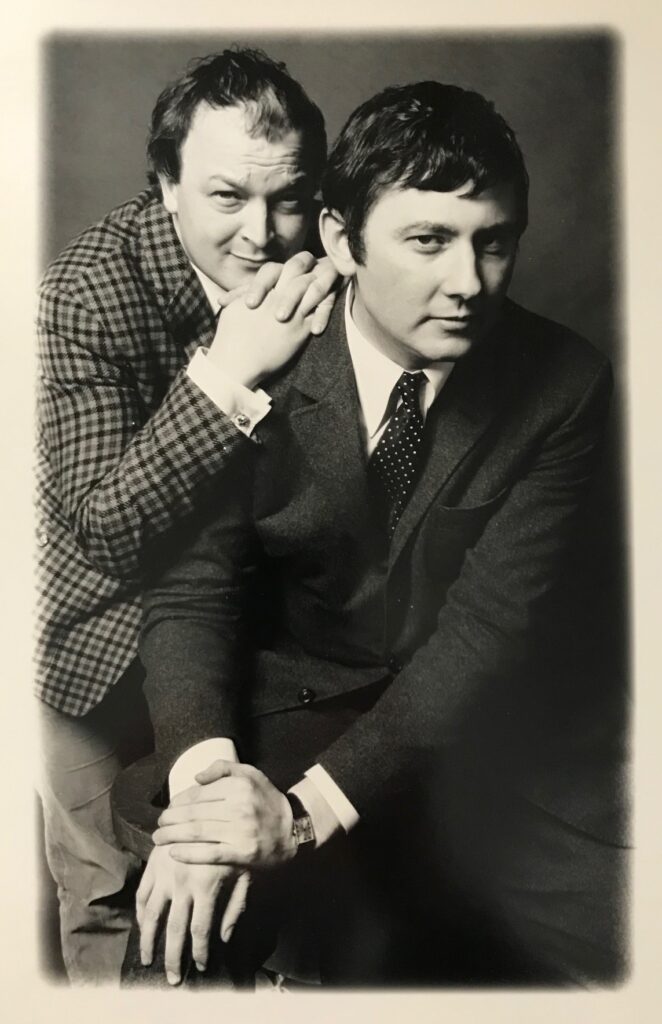
Born in Paddington, north London in 1933, to Irish parents, Duffy grew up in a world defined by conflict, and spent most of his childhood in a city regularly subjected to air raids. During one period of intense bombing he was temporarily evacuated, to the home of actors Roger Livesay and Ursula Jeans. However, through most of the war years he lived in London with his parents. His father, a cabinet-maker, was politically active and at one point had been imprisoned for involvement with the IRA. His mother was from Athlone, had an eye for stylish clothes, and was a devout Catholic. Escaping the confines of a household where religion and Republicanism were closely linked, Duffy and his friends enjoyed the freedom of the city—albeit a freedom tinged with fear—as they explored bomb sites and wrecked houses. Duffy’s parents never moved to the East End. His son Chris Duffy recalls: “my Mum’s parents lived in East Ham and I was brought up there until the age of five, so Duffy’s association with the East End was through my Mum’s side.” David Bailey, five years younger than Duffy, also grew up in this area. A rebellious teenager, often ending up in trouble, Duffy was fortunate to come of age at a time when the recent Butler Act had abolished school fees, opening secondary education to children from working class homes. He was also lucky in attending a progressive school in South Kensington run by ex-servicemen, the purpose of which was to introduce children to a wide range of culture, including opera, galleries and museums.
At the age of seventeen, Duffy enrolled in St. Martin’s School of Art, hoping to become a painter, but, intimidated by the skills and intellectual discussions of his fellow-students, switched to fashion design. At college he met Len Deighton; they formed a life-long friendship. After graduating, Duffy worked for Susan Small, and then for Princess Margaret’s dress designer, Victor Stiebel. Later he worked for Harper’s Bazaar, where the art director Gill Varney showed him how photography and fashion were closely intertwined. Deciding to take up photography, Duffy had a series of short-lived apprenticeships, and a spell at Artist Partners, before being taken on as an assistant in 1956 by Adrian Flowers. Although Flowers came from the same background as did many of the leading photographers of the day—John French had been in the Grenadier Guards, Cecil Beaton had been to Harrow and Cambridge, while Flowers himself attended Sherborne—he recognised and encouraged young talented photographers, irrespective of backgrounds or accents.

Terence Donovan also worked as an assistant in the Flowers studio. During this time Duffy received his first commission, from Ernestine Carter, fashion editor of The Sunday Times magazine. He was a star photographer for this publication for over twenty years, working closely with art director Michael Rand. In 1957 he was hired by Vogue, and grew to admire its editor Audrey Withers, another person willing to take a risk promoting young talent. Duffy loved France and, beginning in 1961, began to spend time in Paris, working for Elle magazine, where Peter Knapp was art director. For Elle he photographed Ina Balke and other models in Parisian street settings, as well as on the Cote d’Azur and Morocco.
Independent, averse to being told what to do, using 35mm cameras and Rolliflexes, working at a fast pace, often in street settings, Duffy, Donovan and Bailey broke many of the conventional rules of photography and were variously referred to as ‘the black trinity’ or ‘the terrible three’. Duffy’s photographs were inventive, with dramatic compositions, often close-cropped. His models, their arms raised in angular poses, sometimes bring to mind the iconography of saints in ecstasy. He was also conscious of cinema, and his photograph of people running underneath cranes could easily be a still from Trauffaut’s 1962 Jules et Jim, while in 1964, his photograph of Celia Hammond, arms outstretched on a street in Florence, could equally be from Kalatozov’s film Soy Cuba, released that same year. This acute visual awareness informs many of Duffy’s images; a model turning and reaching her hand backwards in an open limousine, taken for Town magazine in 1965, recalls the terrified actions of Jackie Kennedy two years earlier in Dallas. Duffy worked for Vogue for six years, photographing Kellie Wilson, Francoise Rubartelli, Jean Shrimpton, Jennifer Hocking, Joy Weston and other top models. Many of the best photographs of Joanna Lumley were taken by him. For Queen magazine he photographed Nicole Da La Marge, Paulene Stone, and Jill Kennington. He also often worked with model Marie-Lise Gres, and in 1962 photographed her at Castletown House in Co. Kildare, a Palladian house being restored by Desmond and Mariga Guinness and the Irish Georgian Society. Duffy also worked for Esquire, the Observer, and The Telegraph, becoming well-known for his portraits. His sitters ranged from politicians to actors, including Harold Wilson, Michael Caine, Ursula Andress, Brigitte Bardot, Nina Simone and Sammy Davis Jnr. At Nova Molly Parkin was another perceptive art director who recognised his talent. For one provocative article “How to Undress for your Husband” the model Amanda Lear posed in states of semi-nudity. Lear had also studied at St. Martin’s and had been a long-time muse of Salvador Dali. Her true gender identity was often the subject of gossip, and she is said to be the inspiration for the character Patsy in Absolutely Fabulous.
In 1966, Duffy was at the peak of his career, when Peggy Roche moved from Elle to become fashion editor of London Life magazine, where David Puttnam, himself the son of a photographer, was managing editor. Duffy took several of the cover photographs for this influential but short-lived magazine. Although the photographs used in Michelangelo Antonioni’s Blow-Up, made that same year, were by Don McCullin, the film was largely based on the work and lifestyles of Duffy, Donovan and Bailey. By the late 1960’s, with Puttnam now his agent, Duffy was moving away from stills photography, and becoming involved with Len Deighton in a film company. The company headquarters were at the bottom of Park Lane, in Piccadilly, the grand offices featuring a partner’s desk, made by Derek Gamble, in the shape of an propeller. Their productions included the 1968 Only When I Larf, and the following year Oh What a Lovely War, films directed by Basil Deardon and Richard Attenborough respectively. The team that travelled to Beirut in 1967 for Only When I Larf included Duffy, Deighton, Brand and Deardon. Having acquired the rights to the musical play Oh What a Lovely War, by Joan Littlewood, Duffy put together a team to film the production on Brighton Pier. However his hopes of directing the film were quashed by trade union regulations so instead he became the producer. Obsessed with World War I, Duffy had an extensive library of books on the topic. He also shot Lions Led by Donkeys a documentary made for Channel 4 about the battlefield of the Somme. David Puttnam’s 1987 film Hope and Glory is a moving depiction of the wartime London in which Duffy had grown up, and which had shaped his attitude to life.
Ever restless, Duffy moved on and began to specialise in more technically-sophisticated photography. In addition to working for the legendary Pirelli calendar, where he used Monaco as the location for his first portfolio in 1965, he photographed the musician David Bowie over a period of several years. The resulting images came to define Bowie’s stage persona, with four being used on album covers, including the 1973 Aladdin Sane. During these years, Duffy also focused on advertising campaigns for CDP, (where Puttnam had also worked), notably those for Smirnoff, Aquascutum, and for cigarette brands Silk Cut and Benson and Hedges, where his surreal visual imagination came into full play. For Aalders Marchant Weinreich he photographed Mary Quant products. He also worked for Biba. However, having conducted the equivalent of a guerrilla war within the elitist world of advertising for almost three decades, in 1990 Duffy retired, to concentrate on the craft of furniture restoration.
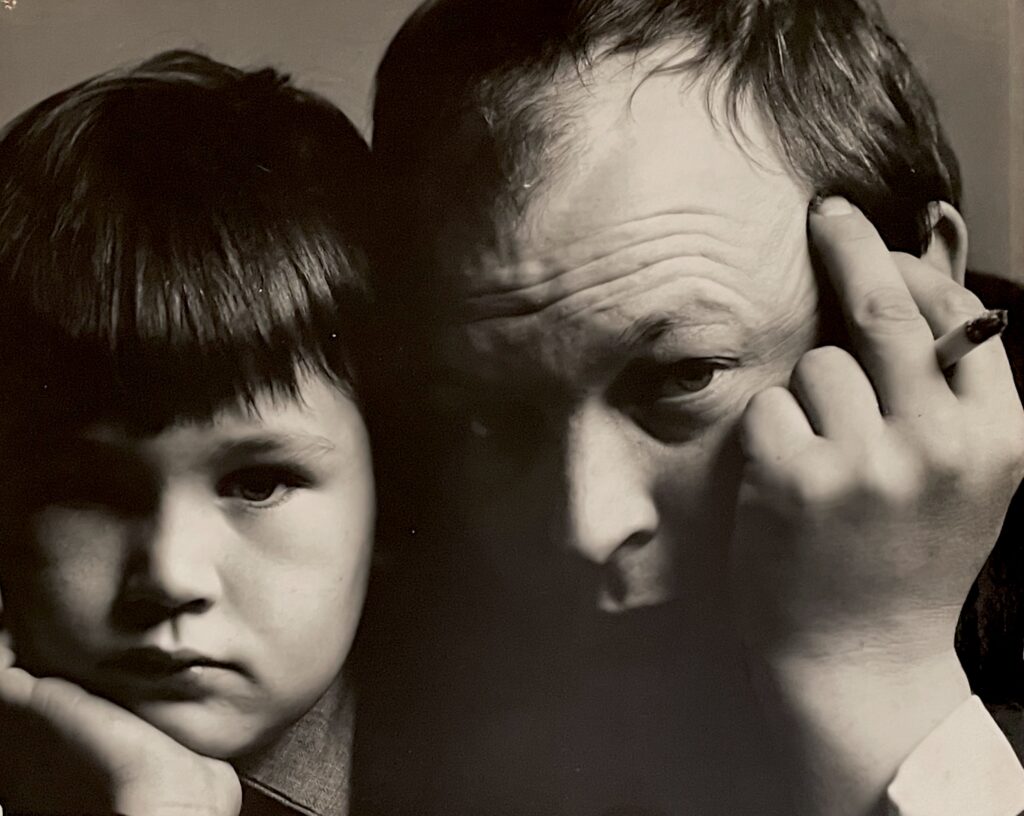
In 2010, two years after his son Chris has founded the Archive that bears his name, Duffy died of pulmonary disease. Unrepentant to the end, he observed “keeping your tongue up the society that pays you is an art of which I was void.” At his funeral the eulogy was delivered by David Puttnam, who observed that ‘the world needs more Duffys’, describing him as a ‘supremely talented and esoteric man . . a man who thrived on risks and challenges, who lived to create.’ Although he had destroyed many of his negatives in the late 1970’s, enough have survived to form a substantial collection. Over the following years, the Duffy Archive has thrived, becoming an invaluable resource of images that define the visual culture of the late twentieth century, and maintaining an online portal for the thirty or so galleries that represent Duffy’s work. Beginning in 2009 at the Chris Beetles Gallery in Mayfair, exhibitions of his photographs have been held around the world. The only showing of his work in Ireland, where both his parents were born and where he was conceived, took place in 2017, at the ebow gallery in Castle Street, Dublin.
Text: Peter Murray
Editor: Francesca Flowers
All images subject to copyright.
Adrian Flowers Archive ©
With thanks to www.duffyarchive.com
12 May 1921 – 23 January 1986
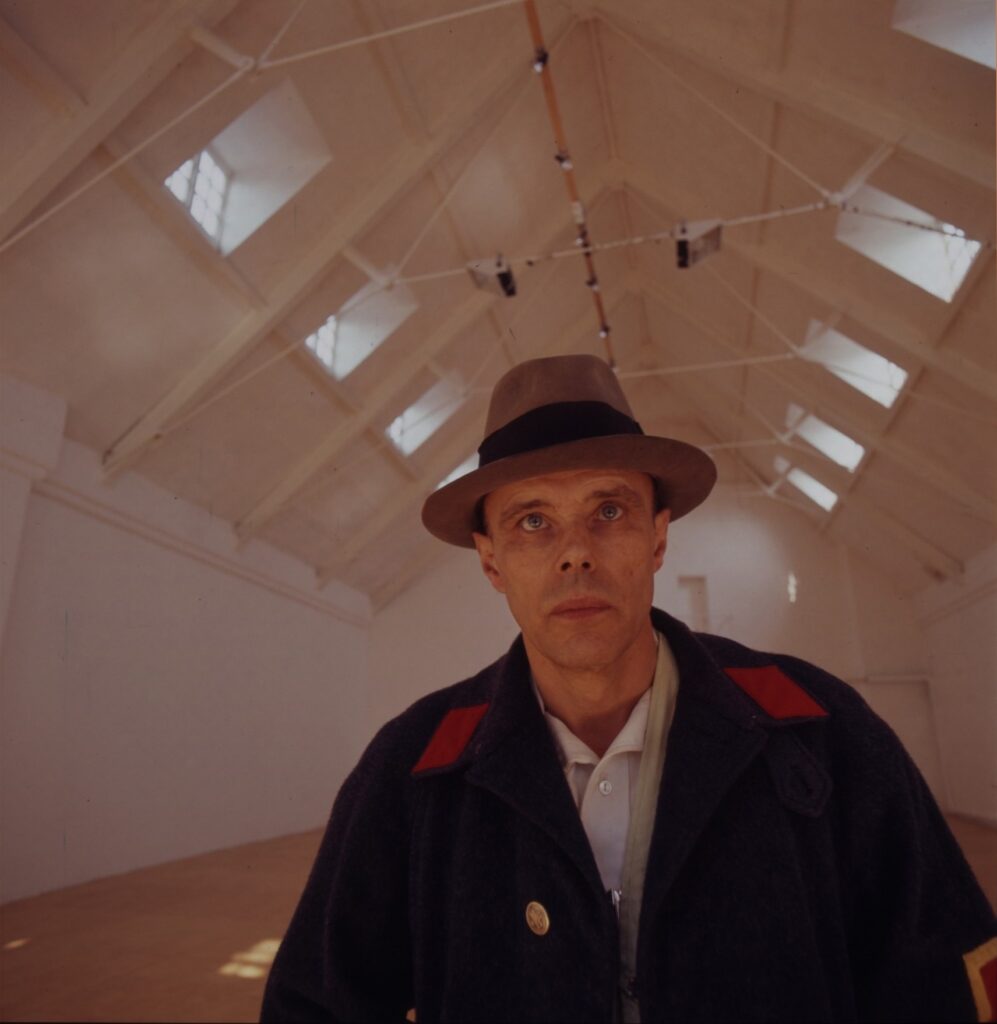
In February 1972, Joseph Beuys, by then something of a star in the international art world, visited London to perform Information Action at the Tate and Whitechapel galleries. The work consisted of a lecture and discussion, with Beuys drawing diagrams and cryptic notes on a series of blackboards, a technique that had become his signature trademark. This was far from being his first visit to the UK; two years previously Beuys had collaborated with Richard de Marco on a series of projects in Scotland. He also worked extensively with writer and curator Caroline Tisdall. The three blackboards resulting from the 1972 London event remained for over a decade in the store of the Tate education department, until in 1983, along with a board from a parallel event at the Whitechapel Gallery, they were accessioned into the Tate collection as artworks in their own right. Although in some respects souvenirs, the boards with their chalked diagrams still convey the excitement of the lectures, which were animated by the charismatic personality of Beuys himself.
A series of photographs, taken by Adrian Flowers at the Whitechapel Gallery in Feb 1972, show Beuys with his characteristic gaunt expression, wearing a grey felt hat with black hatband. His face is lopsided, perhaps as a consequence of injuries received when he served in the German military during WWII. With its armband and brass buttons with crosses, the artist’s coat is also provocative, the red gorget patches on the lapels reminiscent of a military officer. Underneath the coat is visible the fisherman’s vest Beuys invariably wore. Another photograph shows the artist standing on a small balcony, high above the gallery floor, in a pose that again has historical resonances. A third image shows Beuys sitting on the bar of a scaffolding tower. The available props in the Whitechapel gallery space, ladders, towers and steeply raked rooflights, were used effectively, with Beuys becoming an actor in an expressionist stage set.
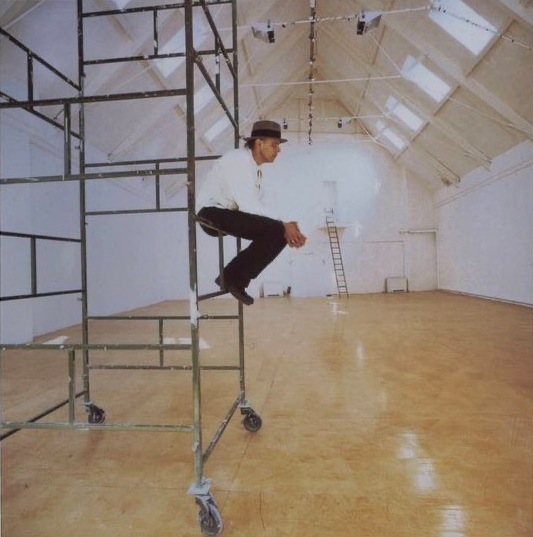
At the time of the Tate/Whitechapel event Beuys was head of sculpture at the Dusseldorf Academy, but his unorthodox teaching methods were becoming increasingly controversial, and in October of that year, notwithstanding protests amongst artists and students, he was dismissed. If anything, this increased his fame and, through association with movements such as Fluxus, over the following decade he enjoyed a successful international career, culminating in a retrospective at the Guggenheim in 1979. Seven years later, shortly after winning the Wilhelm Lehmbruck Prize, Beuys died aged 64. Over the decades following, while much of the mystique that had propelled him to the forefront of the international art scene began to ebb, his life, legacy and philosophies continued to fascinate biographers and critics, often eager to tear aside the veil of veneration with which this charismatic artist was regarded by his followers. He certainly mythologised his own life, creating fictional biographical details—such as his having been a Luftwaffe pilot, shot down in the Crimea, and rescued by local nomadic Tartars, who wrapped him in felt and carried him on a sled to a place of safety. These life episodes, heavily embellished rather than invented, were used by Beuys to explain and underpin the meaning of his artworks, especially his sculptures which often incorporated sleds, fur, fat and felt.
As a teenager, Beuys had been a member of the Hitler Youth, had participated in the 1933 Nuremburg Rally, and later served as a radio operator in the Luftwaffe. His plane was indeed shot down in the Crimea, but he was rescued by German troops and saw further military service before the end of the war. In the post-war years, his art was largely based on a simultaneous reverence and revulsion regarding these aspects of his life. Often, albeit without any trace of humour, he brings to mind the fictional character Schwejk, an anti-hero who forms relationships with animals, and finds himself in absurdist situations. In essence however, Beuys’ ideas were not so innovative or revolutionary, but were based on the writings of Nietzsche and Rudolf Steiner, and on the training he received in the late 1940’s under Ewald Mataré at the Dusseldorf Academy.

Beuys was an idealist, arguing for a spiritual rebirth for mankind, based on qualities of essential humanity. Drawing on shamanistic traditions, he regarded art, or what he called ‘social sculpture’, as a liberating force that could enact social change. He was often deliberately controversial in his lectures and pronouncements, comparing the suppressing of creativity in people—a consequence of industrialisation—as akin to the extermination policies of the Nazis. An ardent admirer of James Joyce, in the late 1950’s Beuys began work on a series of drawings inspired by the novel Ulysses. At one point, encouraged by the art critic Dorothy Walker, he considered setting up a free university in the Wicklow mountains, near Dublin. His assemblage of works, A Secret Block for a Secret Person in Ireland, is in the Museum of Modern Art at Oxford. He was also a frequent visitor to Scotland, where he collaborated with Richard de Marco on projects relating to Celtic history and legend, that formed part of the Edinburgh Festival. Beuys’s work in the UK and Ireland has been documented by his friend Caroline Tisdall, later art critic for The Guardian, who has also organised exhibitions and published several books on the artist.
Text: Peter Murray
Editor: Francesca Flowers
All images subject to copyright
Adrian Flowers Archive ©
1890 – 1956
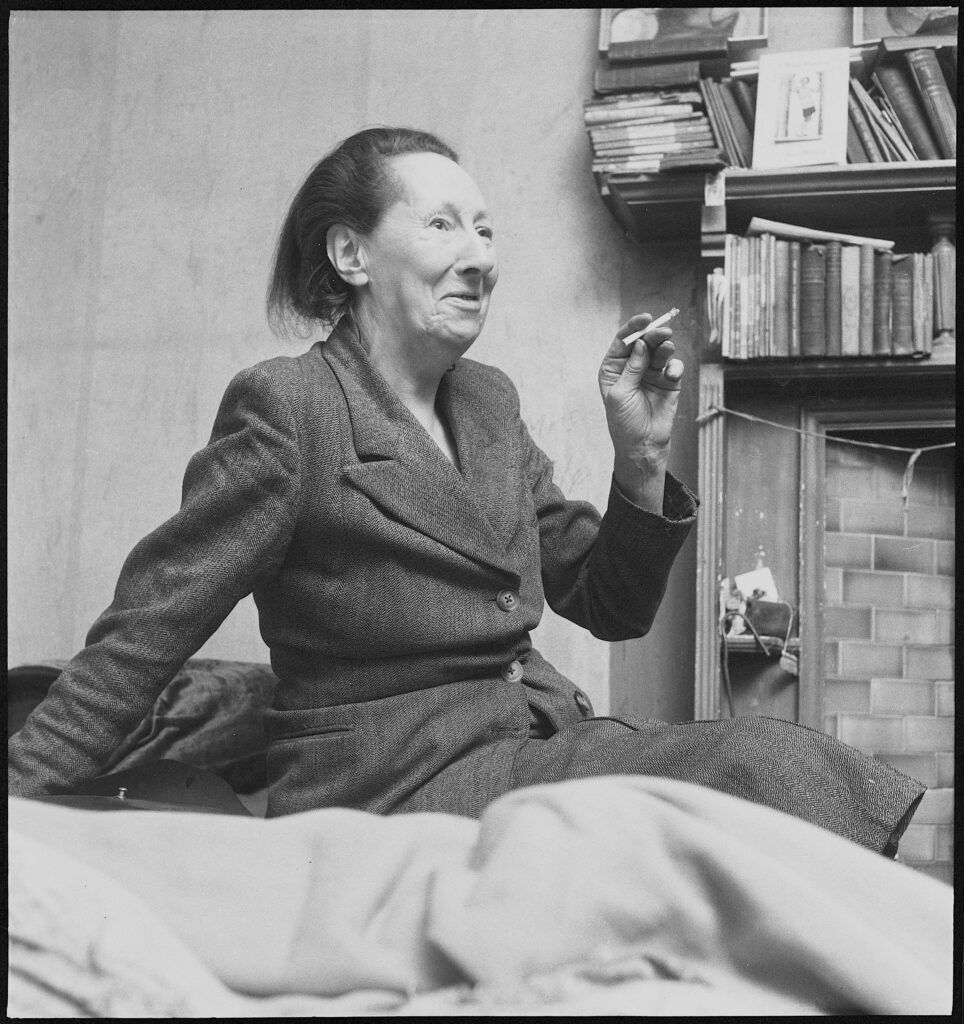
On 7th July 1955, Adrian and Angela Flowers visited the artist Nina Hamnett in her London flat. The photographs Adrian took that evening are among the last visual records of this legendary ‘Queen of Bohemia’. Seated on her bed, Hamnett held forth for her visitors, recounting tales of her life as an artist in Edwardian London and Paris. Cheerful, ravaged, her face like that of an weather-beaten mariner, Hamnett sat, her crutches on the bed beside her. Also on the bed sat a man wearing a vest and smoking a cigarette, his expression thoughtful and pensive. Angela remembers him as a merchant seaman, a friend of Nina’s. There was also a young woman, a journalist. The photographs capture details of Hamnett’s home life, and her love of books and art; above the fireplace were stacked shelves of books, with paintings propped against the wall. A framed drawing of a classical head may have been the same student work for which Hamnett had been awarded a prize, half a century before, at the Portsmouth School of Art. A single candle, on a small footstool beside the fireplace, was likely the only source of illumination when the electricity meter ran out.

In 1955, Hamnett’s second book of memoirs, Is She a Lady?, had just been published, and she was enjoying her time in the limelight. Other photographs taken by Flowers, either on that day or close to it, show her sitting at a bar, with Angela, and also talking to others around her. However, Hamnett’s recollections of her own life were often embellished for literary effect. She told different versions of the same story, and invented episodes, to increase the dramatic effect. She was clearly delighted with the photography session, and dressed up for the occasion.
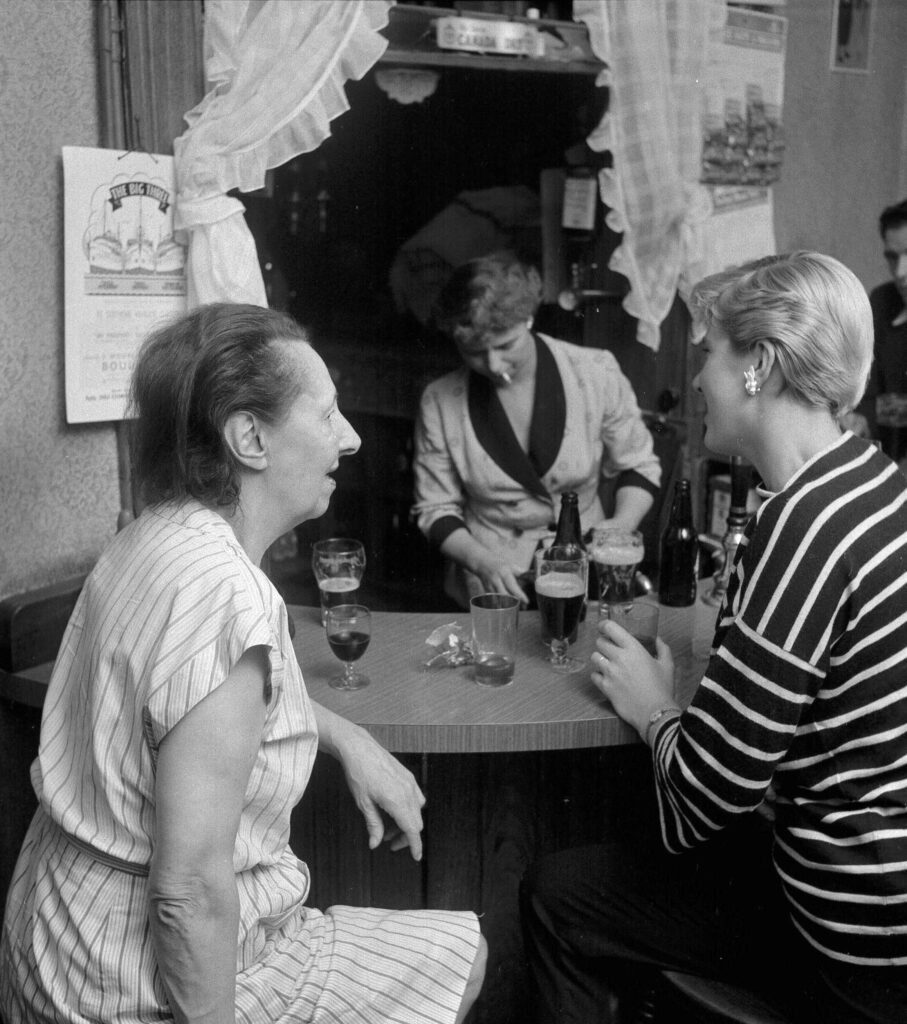
Angela recalls the visit to the bar as having taken place at Little Venice, just north of Paddington Station. The bar was probably in the Bridge House, at Delamere Terrace, close to the Regent’s Canal bridge, an ironwork structure that appears in a 1947 watercolour by Hamnett. In 2019, Kate Thorogood curated an exhibition of Nina Hamnet’s work at the Fitzrovia Chapel, in the course of which she debunked some mythologies, principally the story that Hamnett died in a fall from her flat in Fitzrovia. In fact, Hamnett appears to have moved to Paddington some years earlier: “It is understood that in 1947, there was a fire in her block of flats from which a girl tried to escape by leaping out of the window, only to be impaled on the railings below. Later, Nina would hear this story being told as if she were the one who tragically died. Having been made homeless by the fire and by all accounts refused a place in Marylebone Workhouse, Nina was rehoused in Paddington, not Fitzrovia. It was here she died, also from a fall out of a window. There are many versions of the story of her death, including some in which she dies impaled on the railings. Some claim there was a drunken stumble; others a suicide attempt.” At the time of the Flowers’ visit, Hamnett was just sixty-five, but she was destined to live for just one more year. In 1956, several days after the fall—which was probably accidental—she died in hospital.

Although her death took place in tragic circumstances, Hamnett remains alive in the minds and memories of many, both as a cultural inspiration and a cautionary tale. The story of her life has a stellar quality, but a desire to be the centre of attention led her to forego her own talents as an artist, and to instead become model, dancer, companion, and lover and muse to others, while neglecting her own creative work. Born in 1890, a rackety childhood in Tenby with a grandmother, a couple of years in Ireland with an improvident military father, and teenage forays into London’s bohemia had ill-prepared Hamnett for the conventional career expected of her, of completing a secretarial course, becoming a typist, and settling into suburban life. Having studied at the Metropolitan School in Dublin, then Portsmouth, then the London School of Art, she far preferred the company of sculptors, painters and writers, and, with her hair cut page-boy style and wearing brightly-patterned clothes, enjoyed being stared at by passers-by on the Tottenham Court Road.
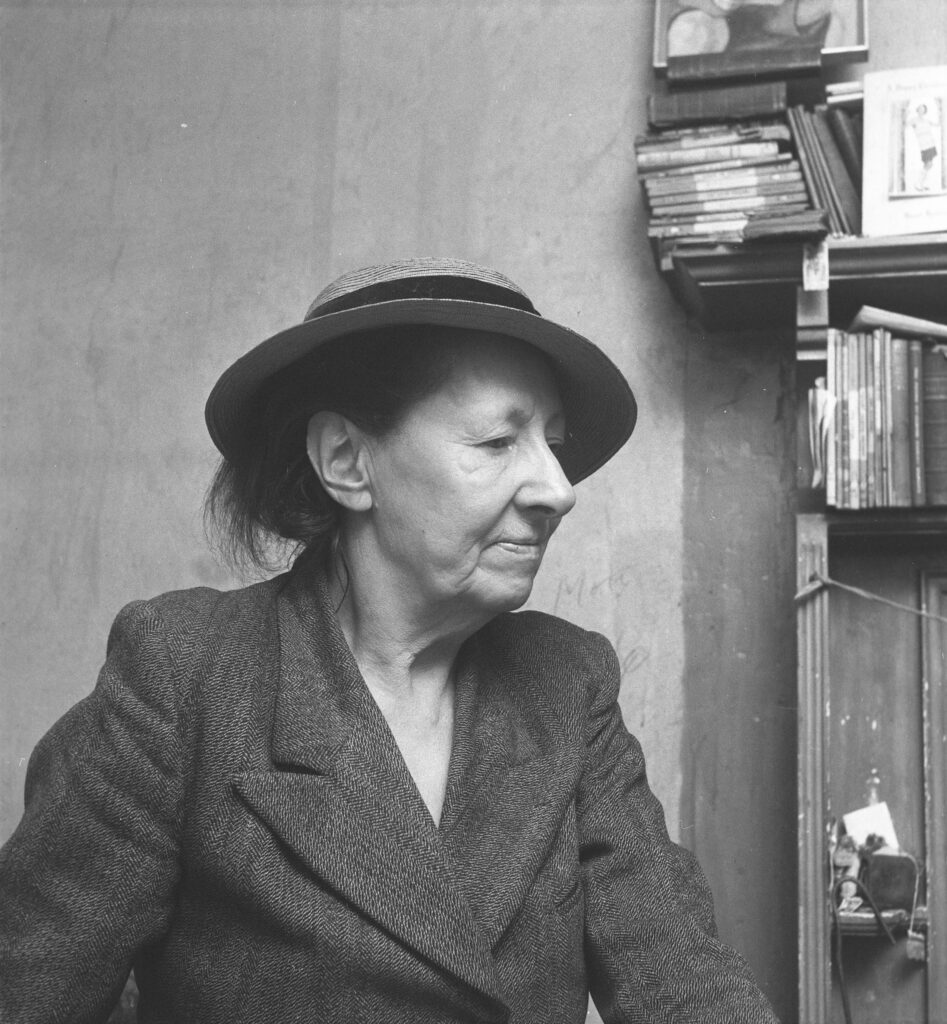
In 1914, at the outset of the First World War, Hamnett was in Paris, hard up, but contriving to remain at the heart of the artistic world that revolved around Montparnasse and La Rotonde. She drank with Zadkine and modelled for Modigliani, in much the same way as, while in London, she had modelled for Roger Fry, Walter Sickert and Henri Gaudier-Brzeska. In Paris, she took off her clothes at parties and, in the manner of Isadora Duncan, danced with a veil, applauded as much by the older women present as by the young avant-garde artists who delighted in this expression of artistic freedom. Although she had male lovers, Hamnett’s friendships with women were often more important to her. She married the Norwegian artist Edgar de Bergen (Roald Kristian) in 1914, but having brought him to England found he was a bore, and was not overly dismayed when he failed to register and was deported back to the Continent as an ‘undesirable alien’. Hamnett then threw herself into the artistic life of London with gusto, dining with Augustus John at the Tour Eiffel restaurant, sketching George Moore and Lord Alfred Douglas at the Café Royal, and working with Roger Fry at the Omega Workshops. In 1917-18 she taught at the Westminster School of Art, and her portraits from these years are among her best. In the 1920’s she moved back to Paris and re-joined the avant-garde, counting Cocteau, Stravinsky and Eric Satie among her friends. These were Hamnett’s most productive years, and she travelled back to London several times to attend openings of exhibitions of her paintings. Two volumes of autobiography preserve the outline, if not the emotional form, of these intense years; published in 1932, Laughing Torso is a window into the avant-garde art worlds of Paris and London, while twenty-three years later, Is She a Lady? brought readers up to date on her spiced-up adventures. Like many of her generation, the First World War had cast a long shadow over Hamnett’s life, and the onset of a second war in 1939 meant that again she could not travel to Paris, and so, over the following two decades, she continued with her bohemian life, holding court at the Fitzroy Tavern in Soho. With alcohol gradually replacing painting, she acquired notoriety, while her friends, in time, disappeared, to be replaced by drinking companions, who to a greater or lesser degree abetted her in this fall from grace. In her formative years, Hamnett’s father, an army officer, had been an overbearing and negative influence, fully expecting his daughter to fail in her determination to live an artistic life. After his death, she went some way towards making up for that disappointment, but remains nonetheless a compelling figure in the world of British avant-garde art.
Text: Peter Murray
Editor: Francesca Flowers
All images subject to copyright.
Adrian Flowers Archive ©
1918 – 1964

In early August 1954, Adrian and Angela Flowers visited Peter Lanyon in ‘The Attic Studio’ in St. Ives, to photograph both the artist and his work. The results are preserved in two rolls of 120 black and white negative film held in the Adrian Flowers Archive. In one photograph, wearing his trademark black beret, and dressed in short-sleeved shirt and sleeveless pullover, Lanyon demonstrates the mixing of artists’ colours, using a muller (mortar) and glass sheet. Another image shows the artist leaning against a cupboard, with Angela seated on a couch beside him. In the background is a book press and a rotary grindstone. Hanging on the wall is the 1948 painting Headland (Tate collection). A third photograph shows the artist standing before his studio easel, pointing out details in a large painting in progress, Blue Boat and Rainstorm. In another image, Lanyon, smiling, leans against his workbench. On the windowsill stands a construction, while hanging on the wall is an antelope horn—a trophy probably brought back from South Africa, where Lanyon, aged twenty, had visited relatives. Also photographed were the slender columnar 1948 Construction, the 1951 Porthleven Boats, both now in the Tate collection, and Construction for Bojewyan Farms, a painted sculpture of curving forms dating from 1952 and now in a private collection. Another work photographed by Flowers that day include Lanyon’s plaster sculpture of a bull, from his Europa series. This was a work in progress, with copper pipes projecting from the animal’s head, forming an armature for plaster horns. The concept for the classically-inspired Europa series had taken shape in Anticoli Corrado, the hilltop town east of Rome, where Lanyon and his wife Sheila had stayed for four months the previous year.

Lanyon was pleased with the photographs, and wrote to Flowers not long afterwards, requesting permission to use a black and white image of one of the works photographed during that session, for a book being produced by Patrick Heron. Lanyon offered to call to Flowers’ studio when he was in London on Monday 20th September, to collect the photograph. To assist Flowers in identifying the work [Construction for St. Just (1952, Tate collection)], Lanyon included a sketch in his letter [PL to AF at 44A Dover Street, letter in AF Archive c Sept 1954]. A painted sculpture made from discarded window panes, and inspired by pencil and charcoal sketches of the town that was once the centre of the Cornish tin mining industry, Construction for St. Just reveals how Lanyon was not only inspired by the art of Naum Gabo, but also used his own three-dimensional works to guide the completion of paintings, described them as akin to the scaffolding used to support a building in progress. In 1953, the painting that resulted from this process, St. Just, was shown at the Hanover Gallery in London in Space in Colour, an exhibition selected by Patrick Heron. It is now also in the Tate collection.
Just ten years later, the early death of Lanyon robbed British art of one of its stars. His career had been short but brilliant, his work carrying forward a Romantic vision, in which the energy and zest of Cornwall’s coastal landscape was infused with European formalism and Mediterranean colour, resulting in paintings that are in every way equal to the best abstract expressionist work produced in America, but also infused with a sense of history and human endeavour.
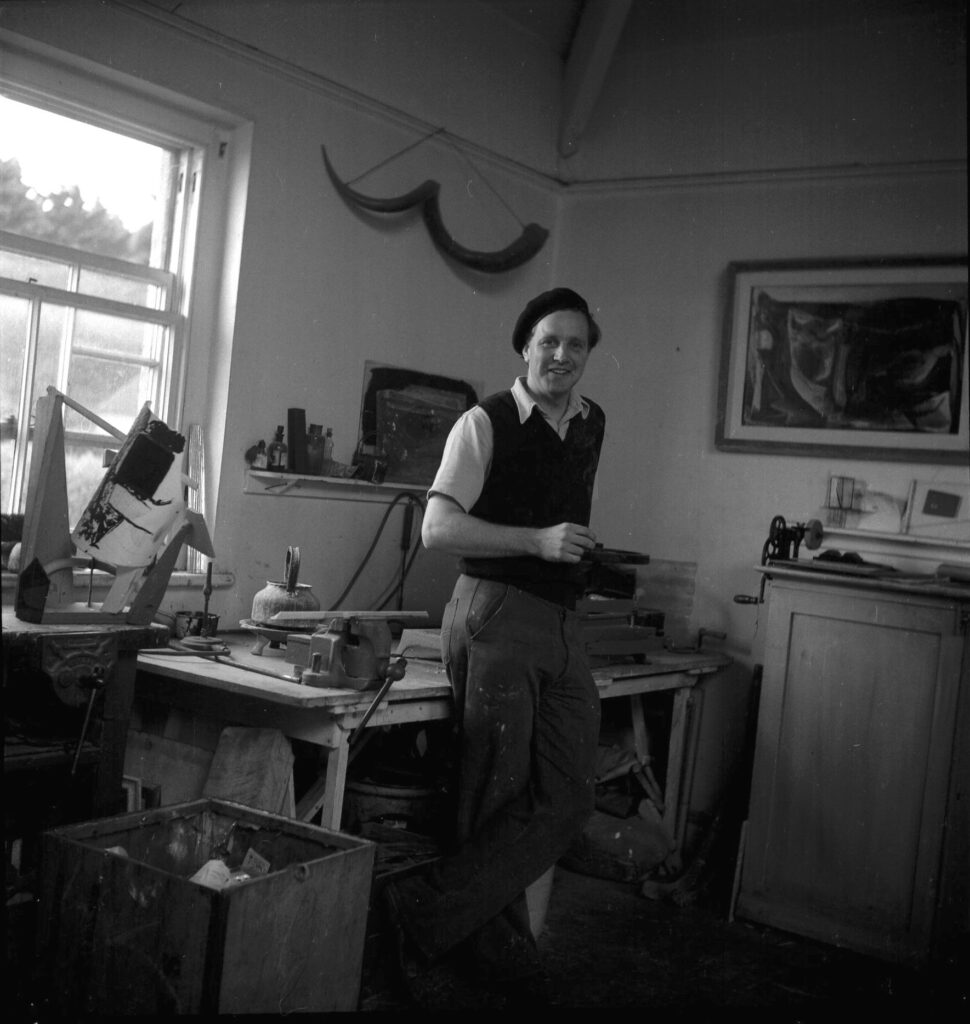
Born into a well-off mining family, and educated at Clifton College in Bristol, Lanyon had taken great pride in his Cornish ancestry. Photography and music were part of his early education, and while still a teenager he took painting lessons with Borlase Smart in St Ives. In 1937 Adrian Stokes advised Lanyon to enroll at the Euston Road School, where Victor Pasmore and Naum Gabo were tutors, and he studied also at the Penzance School of Art. Back in St. Ives, it was inevitable that Lanyon would meet Ben Nicholson and Barbara Hepworth, who had moved to Cornwall in the 1930’s, as did Gabo. During WWII, Lanyon served as a flight mechanic with the RAF in North Africa and Palestine. He was also stationed in Southern Italy for two years, during which time he painted murals and gave lectures on art. He ran an art education workshop for servicemen, developing his own austere, psycho-analytical, but optimistic approach to art. In 1946 he married Sheila St John Browne and over the next decade they had six children; their son Andrew also becoming an artist. Lanyon was inspired by Ben Nicholson’s approach to abstraction, and during the 1940’s made constructions that show the influence of both Nicholson and Gabo. He was a founding member of the Penwith Society of Arts in 1949, and had his first exhibition at the Lefevre Gallery in London that same year. In 1951, as part of the Festival of Britain, the newly-created Arts Council commissioned sixty artists to create large-scale paintings. One of these, Porthleven (British Council collection), an abstract work by Lanyon, is ambitious and hectic, crammed full of allusions to birds, gliders, harbours and quays, the composition surmounted by the clock tower of the Bickton-Smith Institute overlooking the harbour of Porthleven. Lanyon, Heron and Bryan Wynter were also included in the exhibition “Abstract Art”, curated by Adrian Heath at the AIA Gallery, and in another important show, British Abstract Art, held at Gimpel Fils, that same year.
In the early 1950’s Lanyon taught at Corsham College of Art, where William Scott was also a tutor, and later that decade he, William Redgrave and Terry Frost ran a school, at St. Peter’s Loft in St. Ives, with Nancy Wynne-Jones among the artists attending. Lanyon’s first New York exhibition was at the Catherine Viviano Gallery in 1957, when he met Mark Rothko, Robert Motherwell and other artists. Over the following years he showed regularly at the Viviano Gallery. There was a demand for Lanyon’s work in the US, and in 1962 he painted a mural in the house of Stanley Seeger, in New Jersey. Initially tightly constructed, Lanyon’s work during the 1960’s became freer and more painterly. He took up gliding so as to appreciate the physical beauty of the Cornish landscape from the air, but died in a gliding accident in 1964, aged just forty-six.
Text: Peter Murray
Editor: Francesca Flowers
All images subject to copyright
Adrian Flowers Archive ©
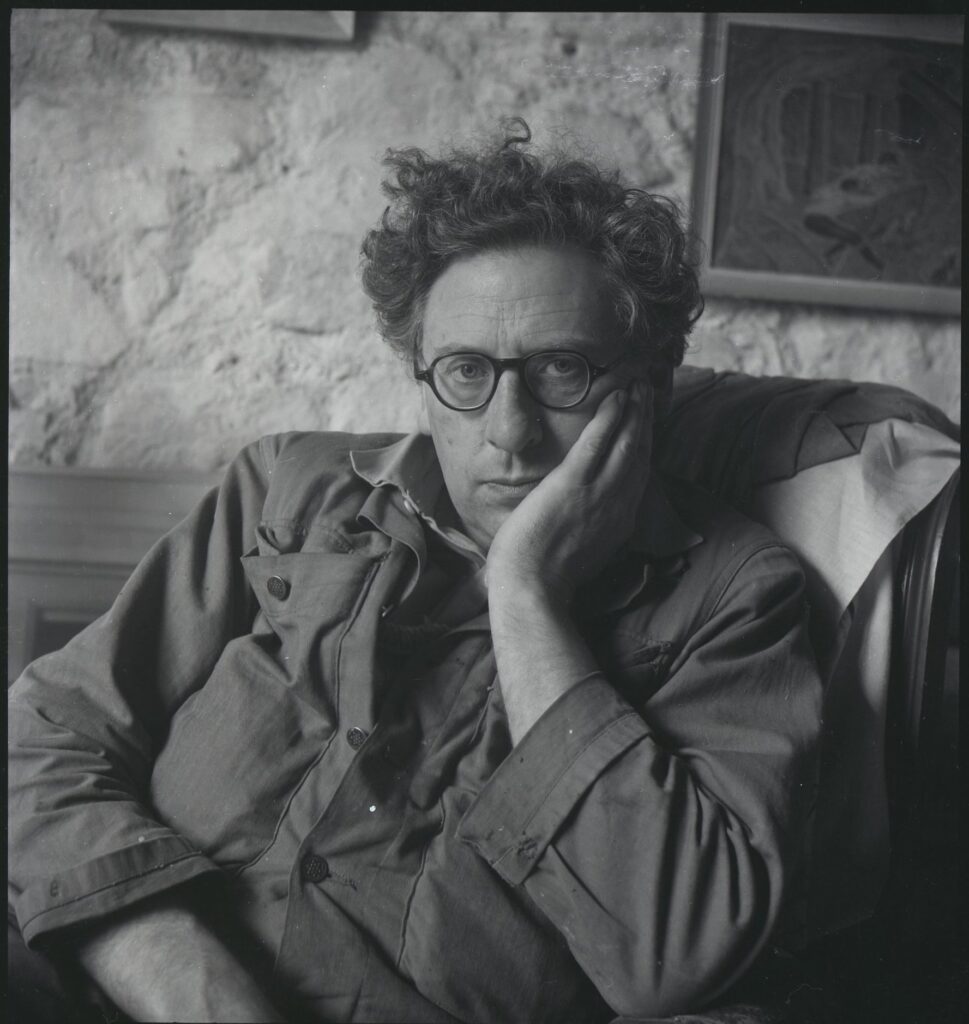
Beginning in July 1954, Adrian and Angela Flowers, and their year-old son Adam, made the first of what was to become a series of regular visits to St. Ives. Setting out to photograph the artists and writers who had made the town famous, during this first visit Adrian also photographed other aspects of Cornish life, including carpenters at work and a traditional mummer.
Denis Mitchell (1912 – 1993)
A sequence of photographs document the studio of Denis Mitchell. An abstract sculptor, working mainly in wood and bronze, Mitchell was an early member of the St. Ives group, having moved to Cornwall from Wales in 1930. Located in the former workshop of plumbers W. F. Smithson, his studio was a timber and corrugated iron building, in a cobbled courtyard off one of the town’s narrow streets. The entrance was decorated with abstract paint marks, perhaps made by Mitchell himself. Upstairs, the interior contained a cast iron stove, workbenches and timber sculptures. The whitewashed walls were decorated with paintings, antelope antlers and an African mask. At the side of the studio was an improvised rack for holding lengths of timber.

Present that September day were Mitchell, Stanley Dorfman and Terry Frost. Angela and young Adam were there also. Mitchell, then in his early ‘40s, was photographed sitting in an Victorian armchair, hand under chin, looking grave and thoughtful. Since moving to Cornwall twenty-four years earlier, he and his brother Endell had contrived to make a living in St. Ives, renovating houses and growing vegetables and flowers. St. Ives was famous for its early spring flowers, violets and the yellow narcissus Soleil D’or. In 1938 Endell became landlord of the Castle Inn on Fore Street, the pub that was later to be the birthplace of the Penwith Society. Around this time Denis, working in a craft market, met Jane Stevens; they married in 1939 and were to have three daughters. During WWII, Mitchell worked in the local tin mines, learning to hew stone deep in the narrow mine shafts. He also served in the Home Guard, where he met the potter Bernard Leach and art critic Adrian Stokes. Encouraged by Leach, in 1946 Mitchell joined the St. Ives Society of Artists, and three years later was taken on as an assistant by Barbara Hepworth at Trewyn Studio. When Adrian photographed him, he had been working with Hepworth for five years, learning the art and craft of abstract sculpture. In 1955 he became chairman of the Penwith Society, and later joined John Wells at his Trewarveneth Studio in Newlyn. Mitchell is credited with inspiring many younger artists, including Broen O’Casey and Conor Fallon. Another photograph by Adrian shows Dorfman and Mitchell standing together in the studio, with Frost descending the staircase. This introduction to the artists of St. Ives ultimately led Angela, some years later, to open her first gallery in London. For two decades Mitchell was one of her leading artists. A major exhibition of his work opened at the Angela Flowers Gallery in March 1993, just before his death.

Stanley Dorfman
A television and film producer, renowned for introducing Top of the Pops to BBC audiences in the 1960’s, Stanley Dorfman was born in Johannesburg, South Africa. Aged nineteen he began to study architecture, but switched instead to fine art and in 1946 was awarded a scholarship to the Ecole des Beaux Arts in Paris. After spending six years in France, Dorfman and his wife and children went back to South Africa to see his parents, but they found the political system there repellent. In 1954, he moved to England, settling in the artists’ colony of St. Ives, where he worked as a studio assistant to Barbara Hepworth, while continuing to develop his own art. His wife and children remained in South Africa until Dorfman could afford to bring them to Europe. His paintings from this early period are hard-edged abstract works, with strong flat colours and titles such as Vertical St. Ives (Paul), Blue and Brown Study, and Composition with Four Rectangles. His 1954 painting Across the Bay features abstracted hard-edge waves.
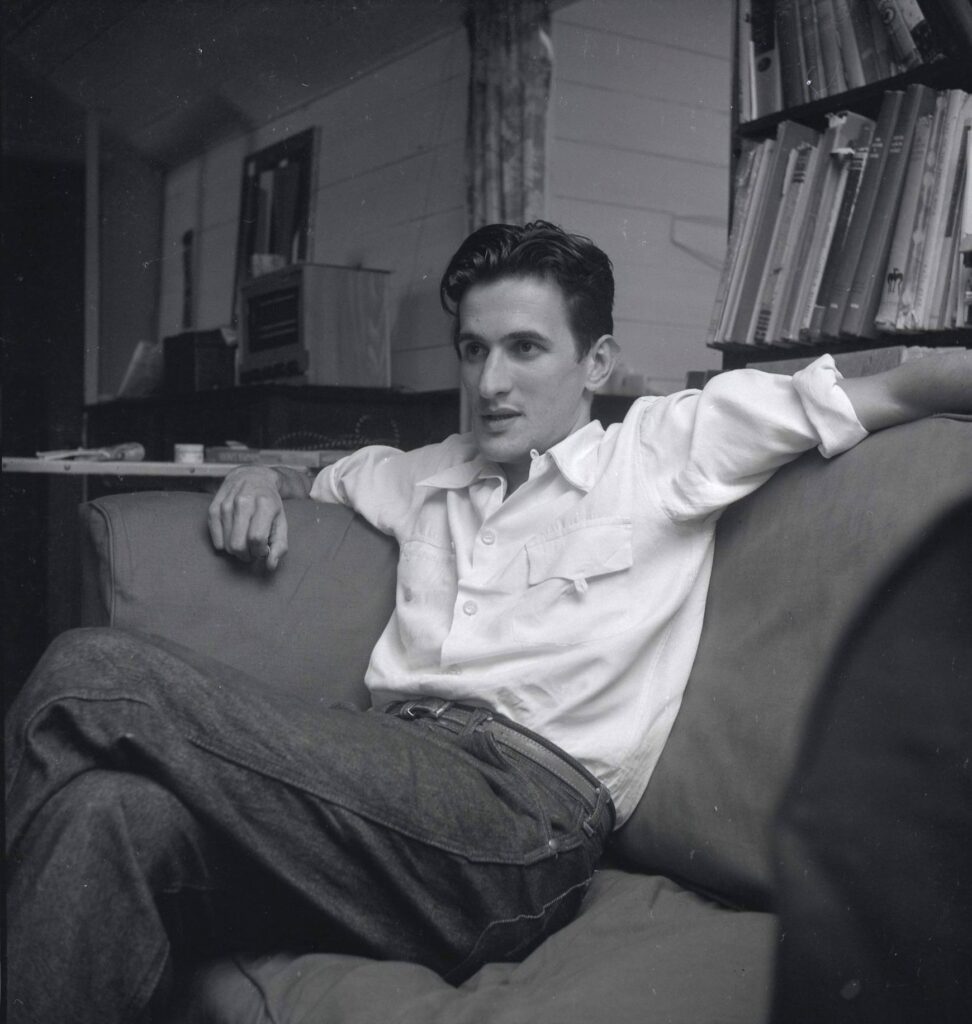
He also created three-dimensional panels which, while paying homage to Mondrian and De Stijl, hark back to mosaic designs and wall pieces he had made in South Africa. In South Africa also, Dorfman had organised music concerts, featuring jazz musicians. This interest in music remained with him, and in 1964 he left St. Ives to work as an art director with BBC television, then as producer and director of the popular weekly music programme Top of the Pops. Meeting Dick Clark who had travelled from the United States to England in search of new talent, Dorfman began to alternate between New York and London. He a created a series for the BBC called ‘In Concert’, beginning with Randy Newman, and followed by Joni Mitchell. In 1968 he had Leonard Cohen on the show. During his long career in British film and television, Dorfman directed over two hundred shows, with musicians such as the Beatles, Rolling Stones, Elton John and David Bowie. In 1974 he decided to relocate to Los Angeles, where he directed and produced music videos for many artists, from Robert Plant to Emmy Lou Harris. He took over Dick Clark’s In Concert series and also worked with Yoko Ono on videos, made using footage taken by John Lennon. He collaborated with David Bowie on two videos, Be My Wife and Heroes, both from 1977, and both in the collection of MoMA. After a career as music producer and director, Dorfman returned to painting. His later works, more lyrical and painterly, often reference music, as in La Bamba and Imagine. His partner of some forty years is the actor Barbara Flood. Dorfman currently lives in Los Angeles, and exhibits his paintings there at The Lodge gallery.
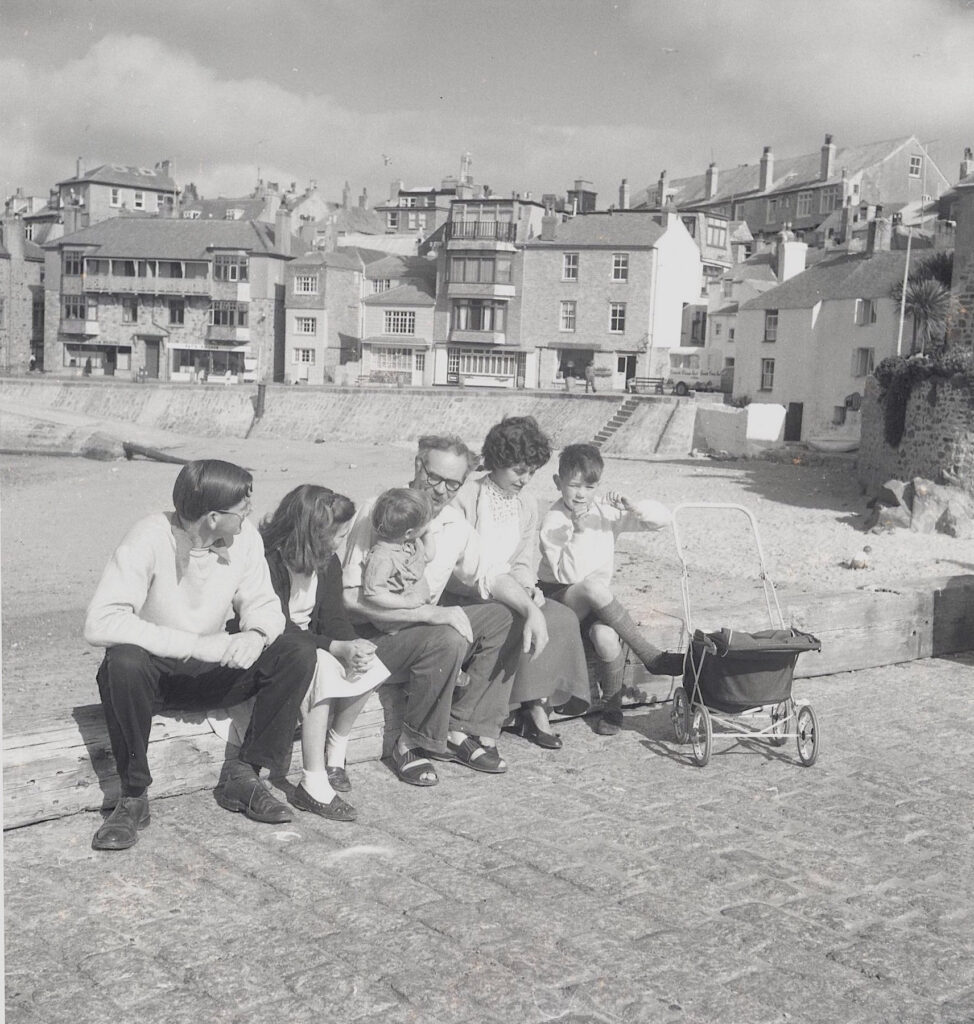
Terry Frost (1915 – 2003)
A second visit by the Flowers family to St. Ives followed in December 1954, and a subsequent visit in May 1956, when Adrian photographed Terry and Kathleen Frost, with their young sons Adrian and Anthony. The group assembled on Smeaton’s Pier, with the harbour and Wharf in the background. Terry’s warm and convivial personality shines through in these images. He and Kath took raising a large family in their stride. He would often get up at 6am, to take the toddlers for a walk on the quay. In one shot, he holds up Anthony, while pointing to the sky.

Born in Leamington Spa, Warwickshire in 1915, Frost had led a varied life before coming to St. Ives. The son of an artilleryman, he left school aged fourteen to work first at a cycle repair shop, then at Armstrong-Whitworth, the company renowned for its battleships and locomotives (and also for the universal ‘Whitworth’ thread that standardised nuts and bolts). By the time Frost went to work for the company at Coventry, it was called Vickers-Armstrong, and was making Whitley bombers, on the wings and fuselages of which he painted RAF roundels. Having enlisted in the Territorials, during WWII Frost served in France, Palestine and Greece. Fighting with the commandos in Crete in June 1941, he was taken prisoner and spent the rest of the war in POW camps. At Stalag 383 in Bavaria, he found he had a talent for sketching portraits of fellow prisoners, using canvases made from hessian pillowcases, primed with glue size made from barley soup. The brushes were made from horsehair. He painted around two hundred portraits, and also met the artist Adrian Heath who encouraged him to take up painting as a profession. Having studied with Stanhope Forbes in Newlyn, Heath was familiar with Cornwall and its tradition of welcoming artists. Frost credited the semi-starvation he experienced during the war as helping him achieve a higher level of spiritual awareness; this no doubt contributed to the qualities of alertness and intellectual presence that characterise his art in the post-war period.
After the war, on returning to England, Frost enrolled firstly at the Birmingham College of Art, then at Camberwell School of Art. In 1945, he married Kathleen Clarke, who had worked in aircraft factory during the war. The following year, forgoing a job as a lightbulb salesman, and availing of his soldiers’ back pay that had built up during years of imprisonment, he moved to St. Ives with Kath and their first-born son. They lived in Headland Row, overlooking Porthmeor beach, while he attended the St. Ives School of Art, and also worked in a café to make ends meet. The St. Ives School was run by Leonard Fuller and Marjorie Mostyn, both dedicated artists: Fuller painted a portrait of Terry Frost with his young son on his knee. In 1947 Frost’s first exhibition Paintings with Knife and Brush was held at Downing’s bookshop. Returning to Camberwell in 1948, he studied under Victor Pasmore, Ben Nicholson and William Coldstream. Pasmore was at this time moving towards abstraction, and Frost followed his lead. Although Madrigal, his first abstract painting, dates from 1949, when the Frosts were back living at 12 Quay Street, on the St. Ives seafront, it is the Cubist-inspired Walk along the Quay, painted the following year, that is regarded as his breakthrough, its bold composition dominated by semi-circles, interrupted by vertical linear areas of blue and khaki green. Walk Along the Quay is the first in a series of paintings, done on hardboard, that show an increasing confidence with abstraction. Another work from this period, Brown and Yellow (c1951-2), is in the Tate collection (although the Tate was initially slow to acquire a work by Frost). Many of his paintings from these years suggest draped fabrics, or the Cornish landscape with long fields terminating in angular cliff edges, as in Blue Winter (1956). Frost showed for three years with the St Ives Society of Artists, and was elected a member of the more progressive Penwith Society. For many years he made prints with Hugh Stoneman. During the 1950’s he exhibited regularly with the Leicester Galleries in London and also taught at Bath Academy, the University of Leeds, and in Cyprus. Although Frost joined the London Group in 1958, over the following decade a new generation of mostly London-based artist came to the fore. As sales of his work flagged, he ceased to show with the Waddington Gallery, and increasingly turned to teaching to help support the family, while continuing to pursue his own art. After Leeds, the Frosts moved to Banbury, Oxfordshire, where they lived between 1963 and 1974, with Terry lecturing at the University of Reading. In the early 1960’s he undertook a residency at San Jose in California, experimenting with new acrylic paints, and also teaching at the University of California. He showed in New York, beginning with the Barbara Schaeffer gallery in 1960, where he met Mark Rothko and other leading artists.
In 1992, Frost was elected a Royal Academician and six years later was knighted. He and Kath had six children in all: five sons, Adrian, Anthony, Matthew, Stephen and Simon, and one daughter, Kate. Stephen is an actor, while Adrian and Anthony followed in their father’s footsteps as artists; Anthony still lives and working in St. Ives. When Alan Bowness was appointed director of Tate, he initiated the idea of a contemporary art museum in Cornwall, to celebrate the work of Frost, Heron, Hepworth and the many other artists who had forged a new approach to art in Britain in the 1950’s. When Tate St. Ives opened in 1993, a large banner by Frost, painted on Newlyn sailcloth, was displayed in the entrance. Terry Frost died in Cornwall in 2003. Twelve years later, on the centenary of his birth, a retrospective exhibition of his work was held at Tate St. Ives.
In the 1956 Smeaton Pier photograph are Terry and Kath Frost, flanked by their sons Adrian and Anthony. To their left is the poet and budding architect David Lewis, who had come to Britain from South Africa (the girl beside Lewis has not been identified). After moving to St. Ives, Lewis became secretary of the Penwith Society and promoter of the town’s artists. Like Frost, Mitchell, Hilton, Dorfman and others, he worked for a time as an assistant to Barbara Hepworth. In 1949, Lewis married Wilhelmina Barnes-Graham. However, seven years later he departed Cornwall, to study architecture in Leeds and to work with Peter Stead on modernist housing. This led to a new career in the United States, where he taught at Carnegie-Mellon University in Pittsburgh and was a co-founder of Urban Design Associates (UDA). In 1985 Lewis was the catalyst for the retrospective exhibition St. Ives: 1939-64, at the Tate Gallery.
Other photographs on that same contact sheet include shots of terraced granite houses on Back Road, and a Land Rover parked on Teetotal Street, where David Lewis lived at No. 4. A narrow thoroughfare, Teetotal Street has changed little over the years, although now it is littered with green wheelie bins. In another photograph, Kath and the girl stand beside a clinker-built boat drawn up on the solid granite setts of the pier; today the boats are gone, their place taken by brightly-coloured plastic surf boards. However surfing has been popular in Cornwall for many years, and in the summer of 1955, the beaches were thronged with holiday-makers, many of them carrying small plywood surfboards.

Text: Peter Murray
Editor: Francesca Flowers
All images subject to copyright.
Adrian Flowers Archive ©
With thanks to Anthony Frost and Colleen O’Sullivan